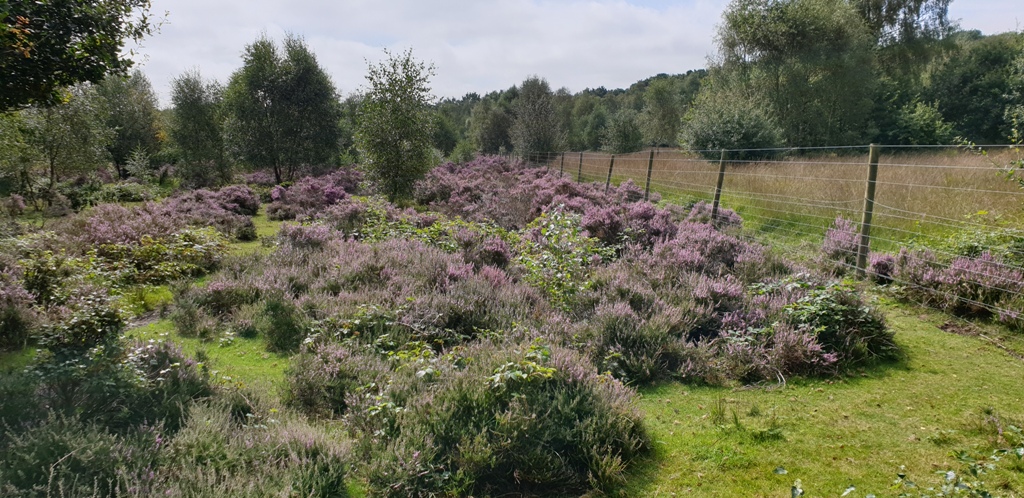
This time of the year, late summer or early autumn, the Heather family or Ericaceae, come to their own!
Many heathlands and mountain sides are painted purple with Calluna vulgaris or Common Heather or Ling as it is also known by.
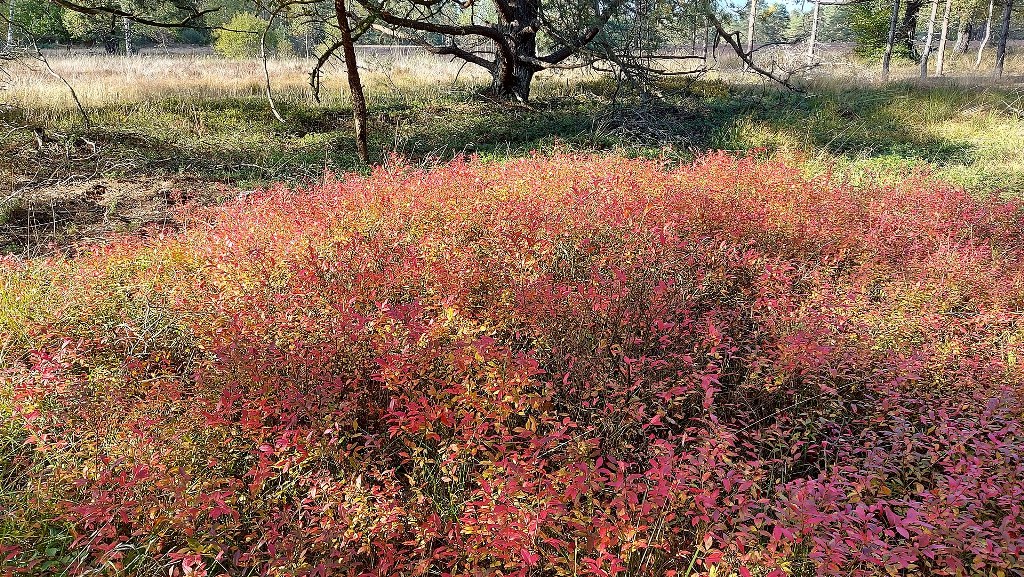
The Vaccinium myrtillus or Bilberry put on their orange and red coats. Not many people know that this family is also very ornamental in Autumn!
According to The Wild Flower Key they are “shrubs (and rarely trees) with simple , usually narrow leathery, mostly evergreen leaves without stipules. Petals are joined into a tube and the fruit is a berry or capsule.
Attractive , distinctive family, mainly low shrubs of acid soils.”
In Stace it is family number 108 and is placed in between two exotic families: the insectiverous Sarraceniaceae or Pitcherplant family and the Garryaceae or Spotted-laurel family.
Stace describes 17 different genera, 5 of which are non-native and introduced as ornamental in the Victorian era or later. All will be listed below in the contents and more fully described on the next page with their known ethnobotanical or wildlife uses.
- A link on the Scientific Name is usually information of the Online Atlas of the British and Irish Flora and the information of ecology of that plant in the B.I. also comes from that website. The link on the Common Name is often from Wikipedia or another good website in the U.K.
- When described in the Flora of Birmingham & Black Country FBBC is added next to the plant in the contents below.
- Most of the ethnobotanical uses are of Wikipedia or PFAFwith links provided.
- Picture credits by Mike Poulton (M.P.), Matt Summers (M.S.) or from Wikipedia Commons.
Contents:
Arbutus unedo or Strawberry-tree
Arctostaphylos or Bearberries
Empetrum nigrum or Crowberry FBBC
Rhododendron or Rhododendrons
R. ponticum and R. luteum or Yellow Azalea FBBC
Phyllodoce or Blue Heath
Kalmia or Sheep-laurels
Daboecia cantabrica or St Dabeoc’s Heath
Calluna vulgaris or Heather FBBC
Erica spp. or Heaths FBBC
Andromeda polifolia of Bog-rosemary
Leucothoe fontanesiana or Dog-hubble
Gaultheria spp or Shallons
Vaccinium spp. or Bilberries, Blueberries, Cowberry, etc. FBBC
Pyrola spp. or Wintergreens
Orthilia secunda or Serrated Wintergreen
Moneses uniflora or One-flowered Wintergreen
Monotropa hypopitys or Hypopitys monotropa or Yellow Bird’s-nest FBBC
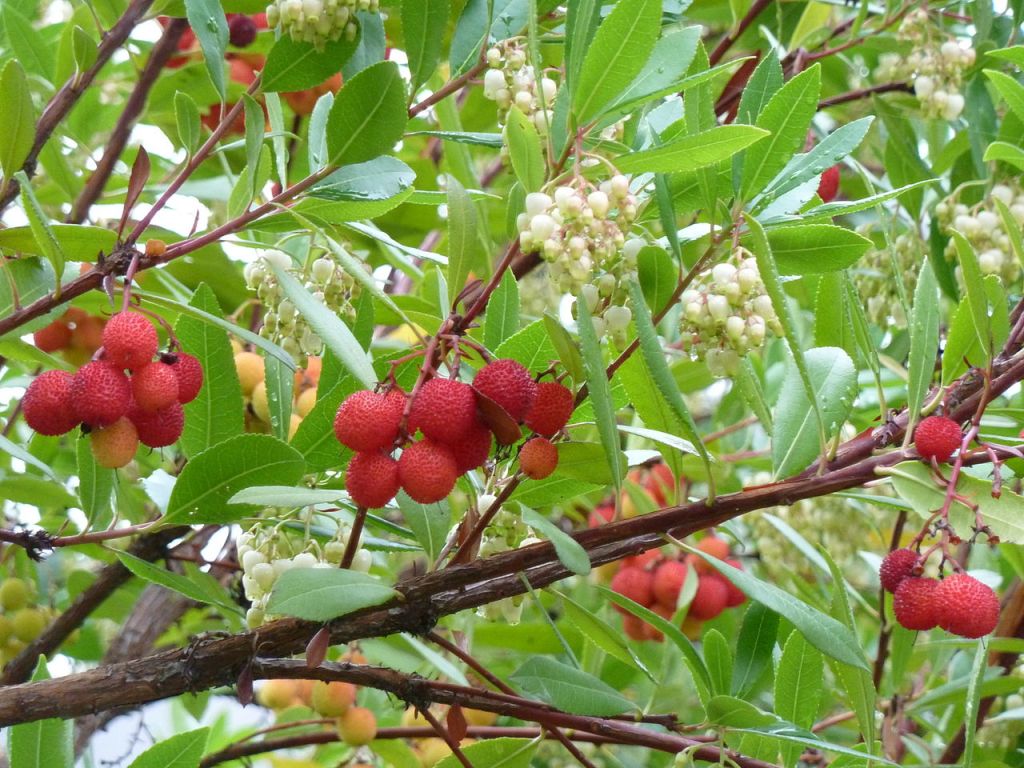
Arbutus unedo or Strawberry-tree
A small tree found as a native in heathy scrub and open woodland on rocky slopes and lake shores, on limestone, conglomerate, slates and sandstones; typically on very shallow soil, or rooted into rock. It also occurs as an escape from cultivation, and has become invasive at the Great Orme (Caerns.) and possibly elsewhere.
Arbutus unedo’s fruits have a high content of sugars (40%), and antioxidant vitamins such as vitamin C, beta-carotene, niacin, tocopherols, and organic acids that are precursors to omega-3 and omega-6 fatty acids (nearly 9%).
They are edible fresh, but that is an uncommon consumption, especially because the mature fruit tends to bruise very easily, making transportation difficult.
They are used mostly for jam, marmalades, yogurt and alcoholic beverages, such as the Portuguese medronho, a type of strong brandy.
The flowers are pollinated by bees, and the resulting honey is bitter tasting but still considered a delicacy!
Arbutus unedo’s leaves have been employed in traditional and folk medicine in the form of a decoction said to have the following properties: astringent, diuretic, urinary anti-septic, antiseptic, intoxicant, rheumatism, tonic, and more recently, in the therapy of hypertension and diabetes.
The leaves are reported to have a high concentration of flavonol antioxidants, especially quercitin, best extracted with a decoction, and together with the fruits are a source of antioxidants.
The leaves also have anti-inflammatory properties.
The nectar contains the isoprenoid unedone (2-(1,2-dihydroxypropyl)-4,4,8-trimethyl-1-oxaspiro[2.5]oct-7-en-6-one) which is biologically active against a common and debilitating parasite of bumble bees, Crithidia bombi, so could provide a naturally occurring way for bees to withstand the burden of disease which has been reported to be a contributing factor in pollinator declines. The compound is glycosylated to an inactive form unedone-8-O-glycoside once consumed by the bee (perhaps to reduce any toxic effects against the bee herself) then transformed back to the active aglycone by the bee’s microbiome in the hindgut where the parasite is most prevalent and damaging – suggesting that the microbiome assists in the anti-parasitic process.
Ornamental Uses and here
The tree is also grown as an ornamental plant, because of its nice-looking and -smelling flowers and fruit and their interesting presence on the plant at the same time, and because it is an evergreen.
From this website: The fruits are popular with birds and although can be eaten by humans, are unpleasant. With its evergreen bay like leaves and rich terracotta brown, tactile, peeling bark and dark evergreen bay like leaves, the feature packed Strawberry tree is very popular.
In landscape design, ecosystem restoration or permaculture based designs, A. unedo can have many purposes. While the ornamental one is the most common, this can be a valuable plant also for restoring degraded ecosystems and preventing desertification. Being a pioneer plant and growing well also in poor soils, it can be used in a wide array of situations.
- The flowers are a significant source of nectar and pollen for bees, while the fruits are food for the birds.
- Its salt tolerance, coupled with it being an evergreen, make it a good choice for wind barriers in lands close to the sea.
- A. unedo is fire resistant (can regrow after a fire), and being a pioneer plant can contribute to the discontinuity of fire-prone pines and eucalyptus monocultures; for the same reasons it is a good candidate for reforestation in Mediterranean areas.
- The dense foliage throughout the year can be a shelter for insects and small animals during the winter.
- Its extensive root system can help in the soil stabilization process.
- The wood is quite hard and well suited for a various uses such as fire wood and to make pipes. Since it does not usually grow straight, it is not well suited for construction or similar uses.
Arctostaphylos or Bearberries
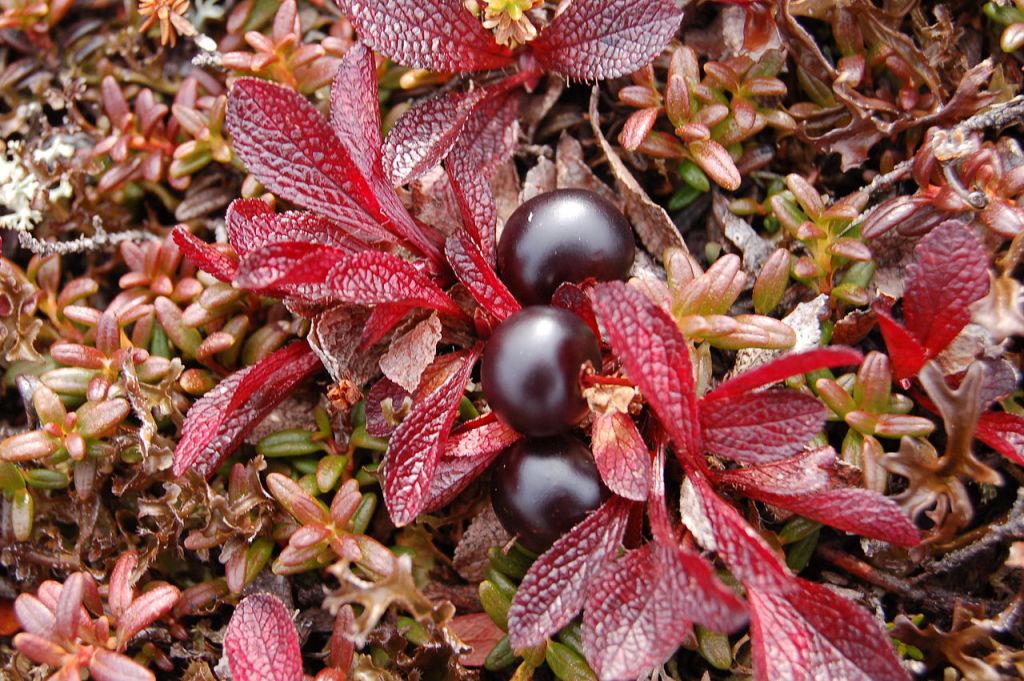
A. alpinus or Alpine Bearberry
A strictly calcifugous shrub growing on acidic mineral soils or peat. It occurs on exposed upland heath, and in the northern Highlands of Scotland also on drier blanket bog. It is possibly long-lived, and fruiting is often sparse.
Arctous alpina forms a symbiotic relationship life with fungi which supply it with nutrients such as phosphorus. The berries are appreciated by birds.
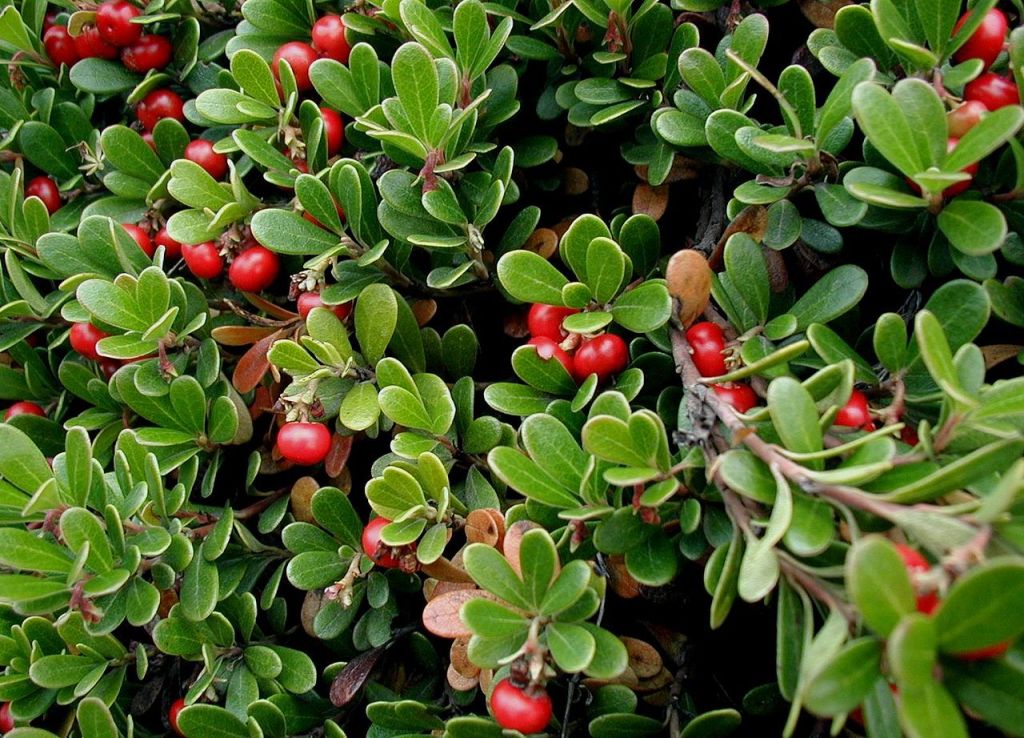
This procumbent low shrub is found on upland heaths and moorlands, often over well-drained gravelly or rocky ground, and on ravine sides. It sometimes grows in heathy grasslands on limestone, as in the Burren.
Ornamental and Environmental uses and here:
There are several cultivars that are propagated for use as ornamental plants. It is an attractive year-round evergreen groundcover for gardens, and is useful for controlling erosion on hillsides and slopes due to its deep roots. It is tolerant of sun and dry soils, and is thus common groundcover in urban areas, in naturalized areas, and in native plant or rock gardens.
This plant is best not used by pregnant women since it can reduce the supply of blood to the foetus. Large doses may lead to nausea and vomiting due to tannin content. Overdoes may result in tinnitus, nausea, vomiting, shortness of breath, convulsions and collapse.
- Fruit – raw or cooked. Insipid, dry and mealy but it becomes sweeter when cooked. Added to stews etc, it is a good source of carbohydrates. The fruit can also be cooked and eaten. They are used for preserves or made into jelly, marmalade, sauces and pastes.
- The ripe fruit can be soaked in water or butter to reduce the dryness. Plants are best harvested after the first frost which sweetens them.
- The fruit can also be used to make a cooling drink or used for preserves etc.
- It can be dried and stored for later use.
- A tea is made from the dried leaves.
Bearberry was commonly used by many native North American Indian tribes to treat a wide range of complaints and has also been used in conventional herbal medicine for hundreds of years, it is one of the best natural urinary antiseptics. The leaves contain hydroquinones and are strongly antibacterial, especially against certain organisms associated with urinary infections. The plant should be used with caution, however, because hydroquinones are also toxic. The leaves are antiseptic, astringent, diuretic, lithontripic, hypnotic and tonic.
- A yellowish-brown dye is obtained from the leaves; it does not require a mordant. A grey-brown dye is obtained from the fruit.
- The dried fruits are used in rattles and as beads on necklaces etc.
- The leaves are a good source of tannin.
- The mashed berries can be rubbed on the insides of coiled cedar root baskets in order to waterproof them.
- A good ground-cover for steep sandy banks in a sunny position or in light shade. A carpeting plant, growing fairly fast and carpeting as it spreads.
- It is valuable for checking soil erosion on watersheds.
- This is also a pioneer plant in the wild, often being the first plant to colonize burnt-over areas, especially on poor soils.
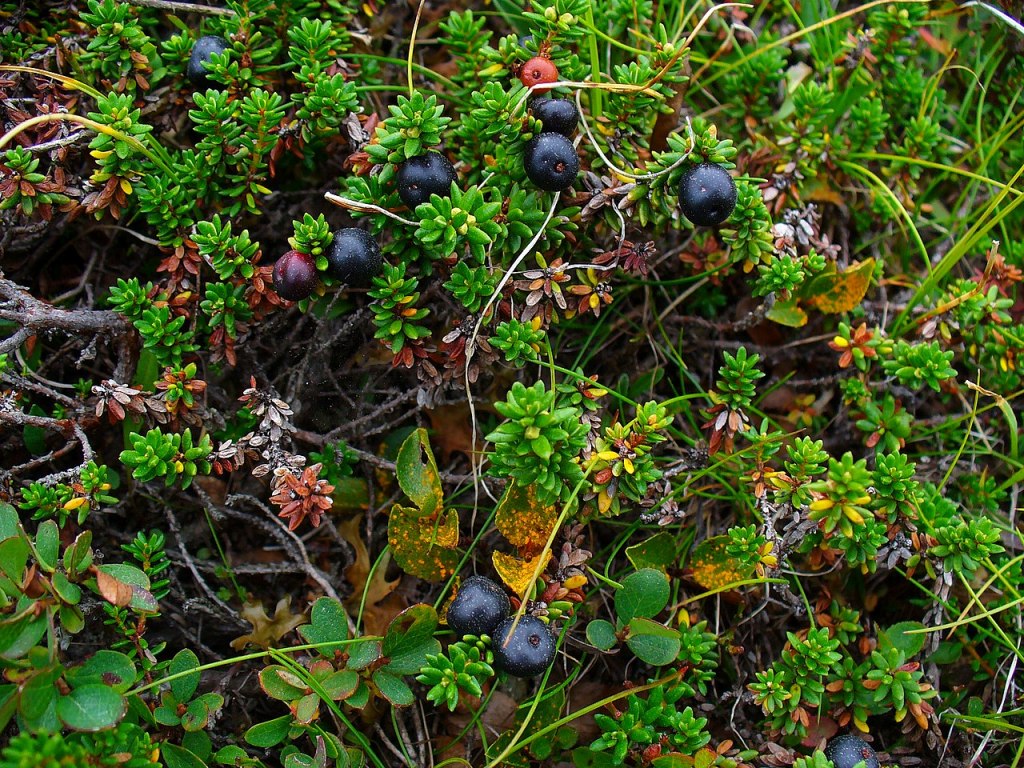
Empetrum nigrum or Crowberry
A low-growing evergreen shrub of well-drained acidic soils. It is found on moorlands and mountains, and on blanket mire where it can increase greatly after burning or where dry surfaces have been bared by erosion.
Empetrum nigrum subsp. hermaphroditum
As above and occurring in dwarf shrub and Racomitrium heaths, rock crevices and dry heather moor, including areas of late snow-lie. Usually montane, occurring from 610 m to 1130 m in the Cairngorm (Easterness), but formerly on coastal dunes.
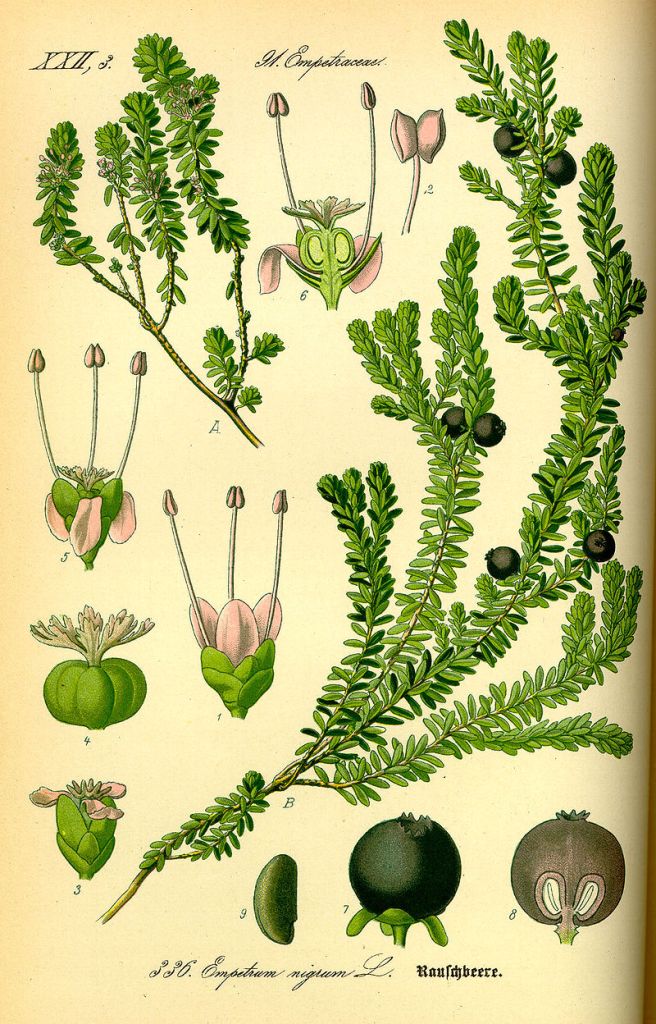
The Scottish Highlands Clan Maclean‘s badge is believed to be E. nigrum; cuttings of it would be raised on standards to denote clan identity and allegiance.
- Fruit – raw or cooked. It can taste slightly acid or insipid. Not very desirable, it tastes best after a frost.
- A watery flavour, it is mainly used for making drinks, pies, preserves etc. The fruit dry or freeze them for winter use.
- A tea can be made from the twigs.
- The leafy branches have been used, especially for children with a fever, as a diuretic.
- It has also been used to treat kidney problems.
- A decoction or infusion of the stems, or the cooked berries, have been used in the treatment of diarrhoea.
- A decoction of the leaves and stems, mixed with Hudson Bay tea and young spruce tree tips, has been used in the treatment of colds.
- A decoction of the roots has been used as an eyewash to remove a growth.
- A purple dye is obtained from the fruit.
- Can be used for groundcover in exposed locations; easily grown in a lime-free soil.
Rhododendron spp
2 species are known on the B.I.:
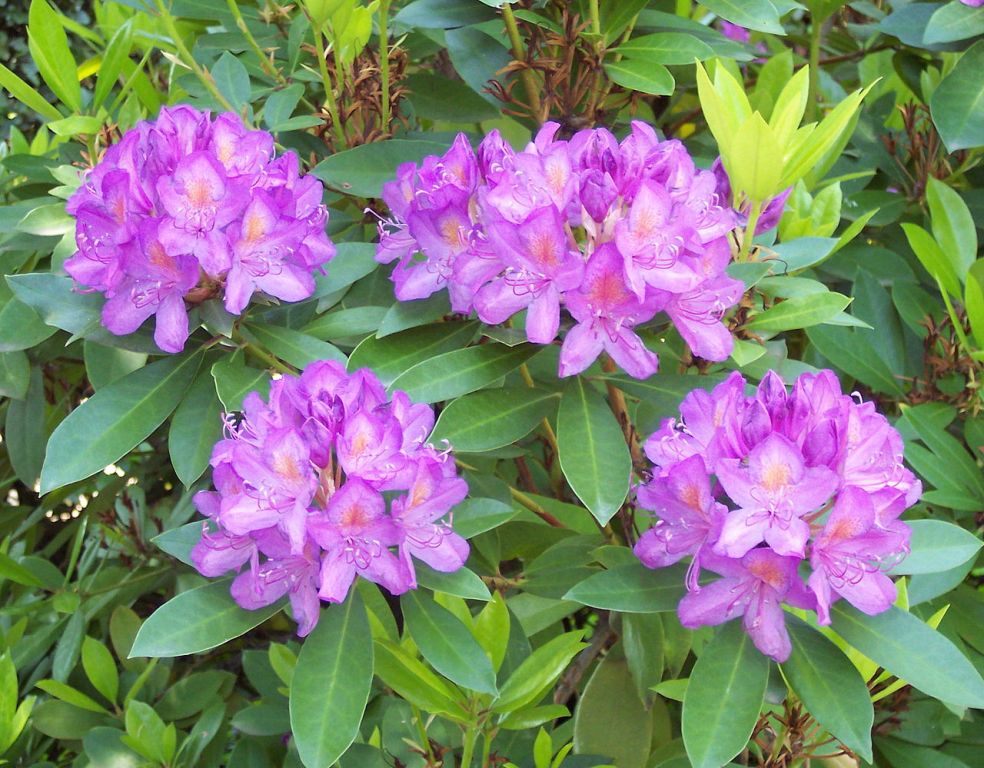
Rhododendron ponticum or Common Rhododendron
A well-known evergreen shrub naturalised on heathy and rocky hillsides, rocky stream banks and ravines, and as an understorey in woodland on acid soils. It regenerates from seed freely and can form dense thickets.
The pollen record shows that R. ponticum was native to Ireland in the Hoxnian interglacial. In the current interglacial it was introduced to cultivation in 1763 and most, if not all, our plants derive from Spanish stock. It was known in the wild by at least 1894 and spread widely in the 20th century.
It was noted by the botanist Joseph Pitton de Tournefort during his travels in the Near East in 1700–02, and so received its name from Linnaeus to identify the ancient kingdom on the south shores of the Black Sea, Pontus, in which it grew. At the other end of its range, in southern Spain, Linnaeus’ friend and correspondent Clas Alströmer found it growing with oleander. It was introduced to Britain as an ornamental shrub in 1763, and later planted as cover for game birds.
This evergreen with its beautiful, exotic flowers is now considered to be an invasive species.
Conservation organisations now believe it has become “a severe problem” in the native Atlantic oakwoods of the west highlands of Scotland and in Wales, and on heathlands in southern England, crowding out the native flora.
A study in the journal Functional Ecology also showed that rhododendron nectar was toxic to European honeybees (Apis mellifera), killing individuals within hours of consumption. It also paralyzed bees of the species Andrena carantonica. Bees became paralysed and exhibited excessive grooming or other distress behaviours after feeding on rhododendron nectar, and ate less food than bees fed a control nectar. In contrast the buff-tailed bumblebee (Bombus terrestris) was not affected by the rhododendron nectar. It is important not to see Rhododendron as a problem species for honey bees as they actually avoid the flowers owing to their ability to detect the toxin nectar. The toxicity is caused by grayanotoxin 1 which is one of several highly hydroxylated diterpenoid defence chemicals produced in the leaves of Rhododendron to protect against herbivores – e.g. the Thrips Heliothrips haemorrhoidalis. Some species of honey bee (Apis mellifera sub spp caucasica) tolerate the toxin and make so called mad-honey.
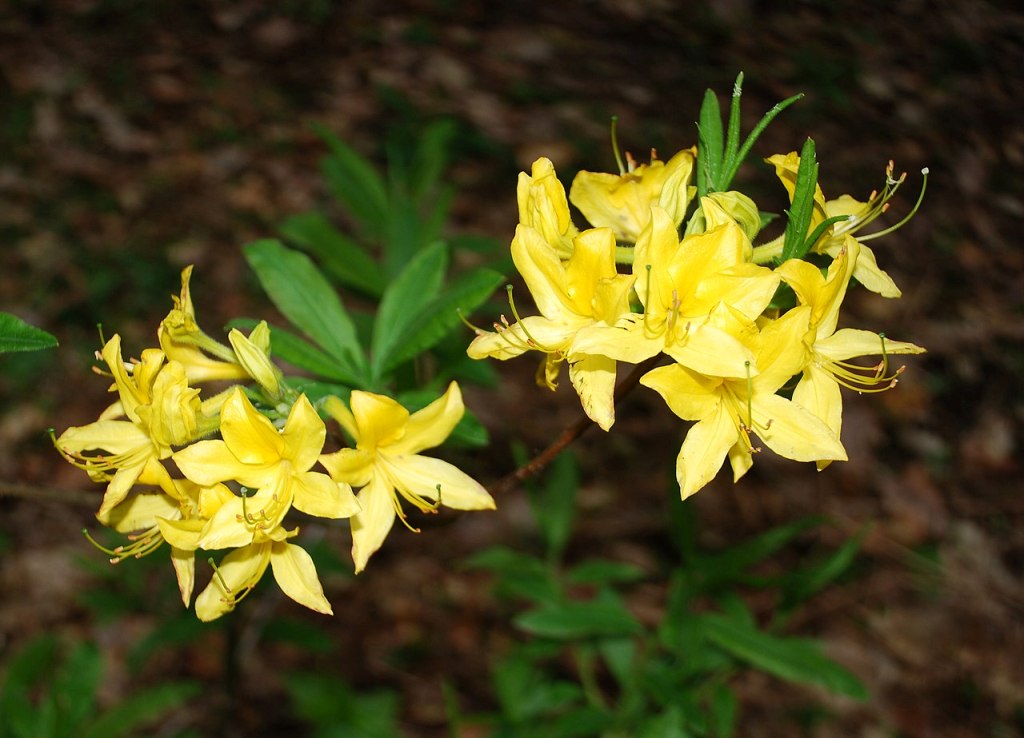
Rhododendron luteum or Yellow Azalea
A deciduous shrub, locally naturalised on acidic soils on heathland, moorland and in open woodland. Introduced into cultivation in 1793, R. luteum is commonly grown in gardens for its beautiful, fragrant yellow flowers. It was recorded from the wild in 1939.
It is widely cultivated in western Europe, used both as an ornamental plant in its own right, and as a rootstock onto which other azalea cultivars are grafted. It is locally naturalised in western and northern Europe.
In Great Britain it has colonised many wet heaths and bogs, but unlike its relative Rhododendron ponticum it does not usually form dominant stands and so is of lower nature conservation concern.
However it is listed under Schedule 9 of the UK Wildlife and Countryside Act 1981 as a non-native invasive species. While it is legal to sell and grow it in gardens, users are expected to take care when disposing of material from this plant.
R. luteum has gained the Royal Horticultural Society’s Award of Garden Merit.
Despite the sweet perfume of the flowers, the nectar is toxic, containing grayanotoxin; records of poisoning of people eating the honey date back to the 4th century BC in Classical Greece.
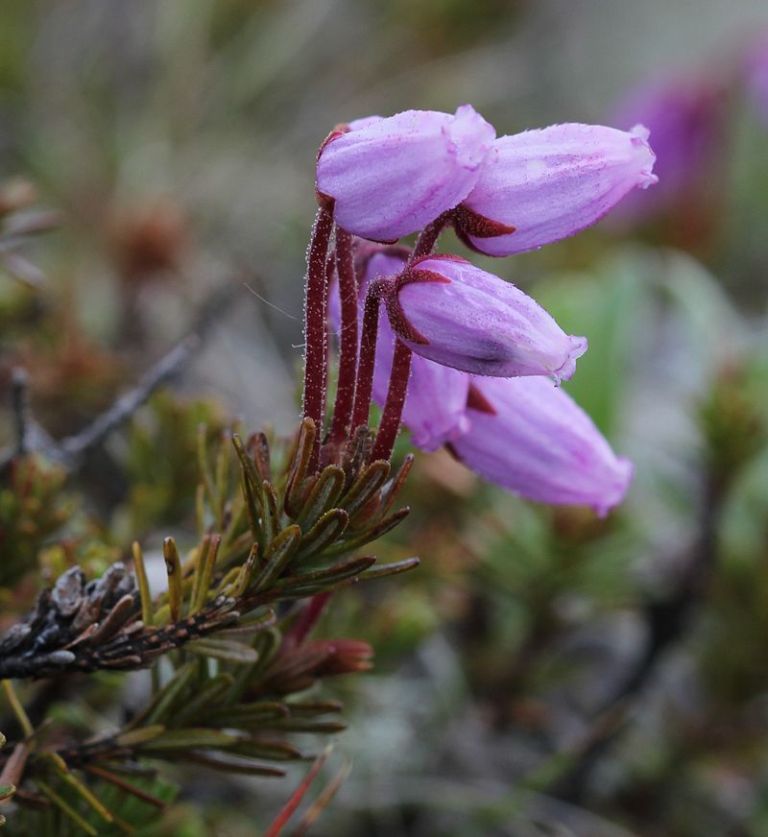
Phyllodoce caerulea or Blue Heath
This low shrub occurs in acidic, free-draining sites on steep, usually N.- to E.-facing rocky mountain slopes. It is usually found in dwarf shrub communities, though it sometimes occurs in herb-rich grassland. All sites have a prolonged snow-lie. Flowering is irregular, and seed production generally poor.
Kalmia or Sheep-laurels
There are 4 species known according to Stace.
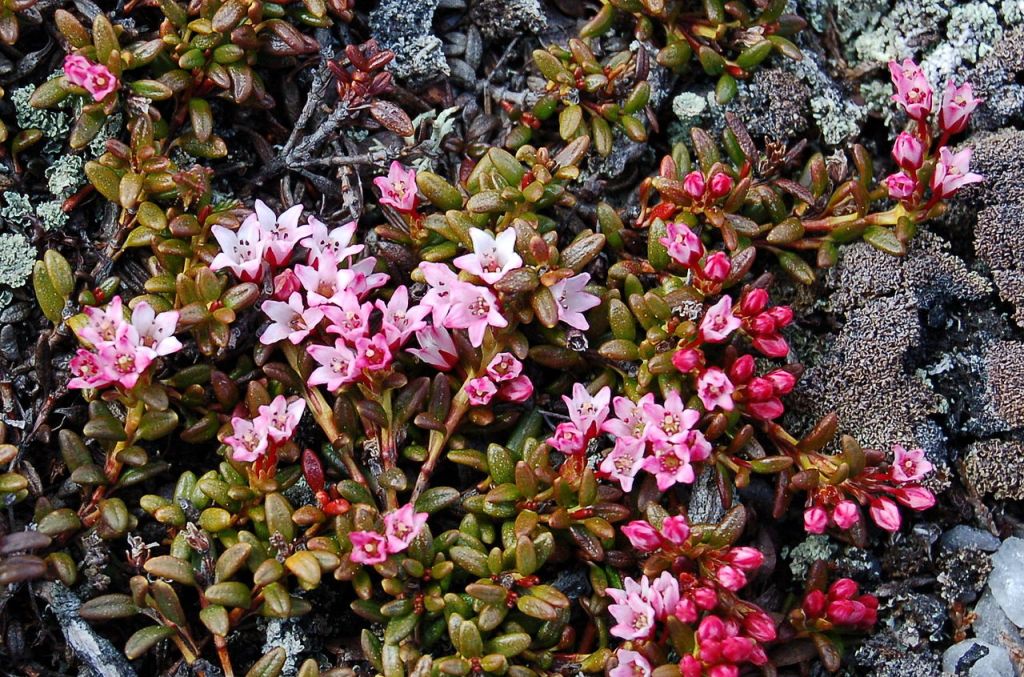
Kalmia procumbens or Trailing Azalea is a new name for Loiseleuria procumbens given by Clive Stace in New Flora of the British Isles Edition 3 in 2010. It is the only true native Kalmia, the other 3 species are neophytes.
This procumbent, calcifugous dwarf shrub is found on exposed, stony mountain heaths on dry ridges and plateaux. Reproduction is mainly by seed, but it also spreads by rooting of the procumbent stems.
This is a plant of the Scottish highlands not usually being found below 1,200 feet and more commonly higher than that. Finding Kalmia procumbens means you are in the start of the alpine region and should look out for the alpine club mosses and other common plants of the high places.
It is predominantly north western in its distribution and is not found in Snowdonia, the Lake district although the mountains are high enough. It is absent from Ireland.
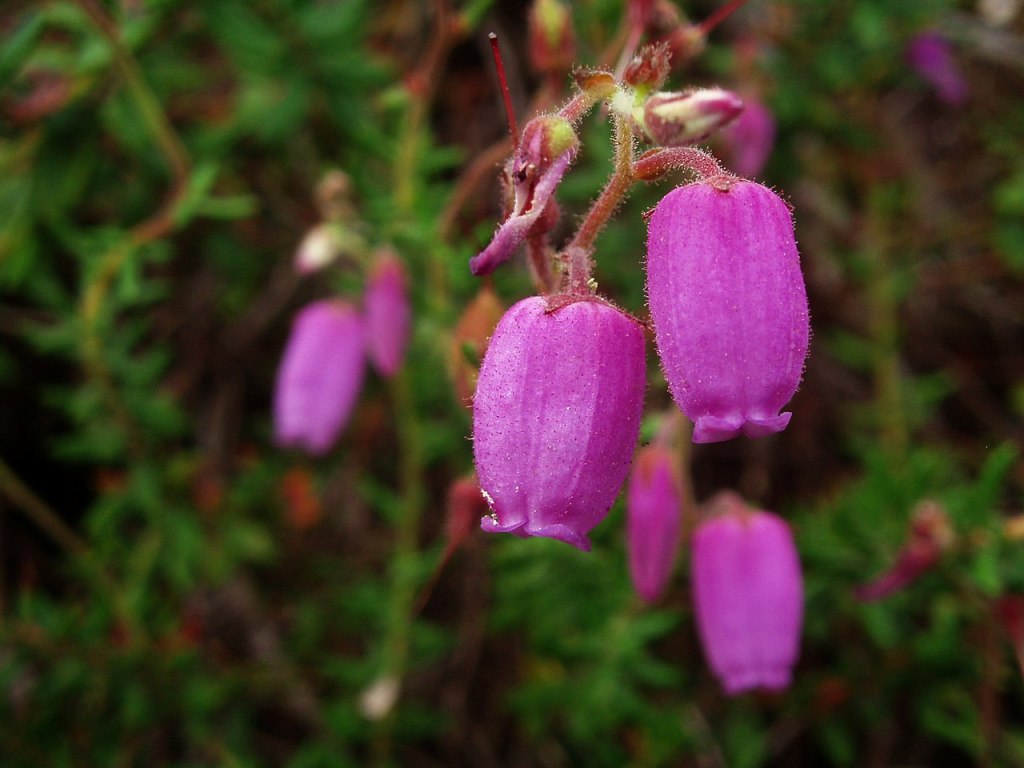
Daboecia cantabrica or St Dabeoc’s Heath
This straggling, low shrub occurs on heathland and moorland, often on rocky terrain, usually with other shrubs including Calluna vulgaris, Erica cinerea and Ulex gallii. It grows in thin acidic soils over quartzites or mica-schists, avoiding peat.
The following cultivars have gained the Royal Horticultural Society’s Award of Garden Merit (confirmed 2017):
- D. cantabrica ‘Waley’s Red’
- D. cantabrica subsp. scotica ‘Silverwells’
- D. cantabrica subsp. scotica ‘William Hicks’
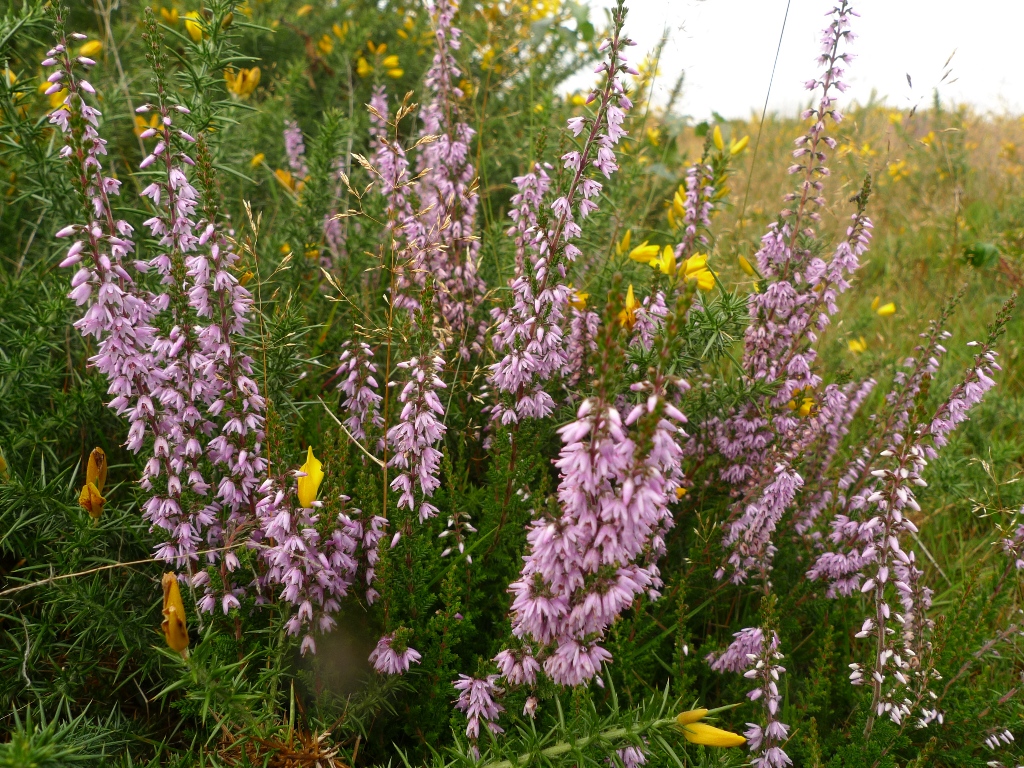
Calluna vulgaris or Heather
A low shrub, often dominant on heaths, moors and nutrient-poor grasslands, and in open woodland on acidic soils, ranging from dry exposed habitats to wet peat bogs. It can colonise newly available habitats.
- Heather is an important food source for various sheep and deer which can graze the tips of the plants when snow covers low-growing vegetation. Willow grouse and red grouse feed on the young shoots and seeds of this plant. Both adult and larva of the heather beetle (Lochmaea suturalis) feed on it, and can cause extensive mortality in some instances. The larvae of a number of Lepidoptera species also feed on the plant, notably the small emperor moth Saturnia pavonia.
- Formerly heather was used to dye wool yellow and to tan leather.
- From time immemorial heather has been used for making besoms, a practice recorded in “Buy Broom Buzzems” a song probably written by William Purvis (Blind Willie) (1752–1832) from Newcastle-upon-Tyne, England.
- Heather honey is a highly valued product in moorland and heathland areas, with many beehives being moved there in late summer. Heather honey has a characteristic strong taste, and an unusual texture, for it is thixotropic, being a jelly until stirred, when it becomes a syrup like other honey, but then sets again to a jelly. This makes the extraction of the honey from the comb difficult, and it is therefore often sold as comb honey.
- Heather stalks are used by a small industry in Scotland as a raw material for sentimental jewellery. The stalks are stripped of bark, dyed in bright colours and then compressed with resin. (called: Heathergems)
- Calluna vulgaris herb has been used in the traditional Austrian medicine internally as tea for treatment of disorders of the kidneys and urinary tract.
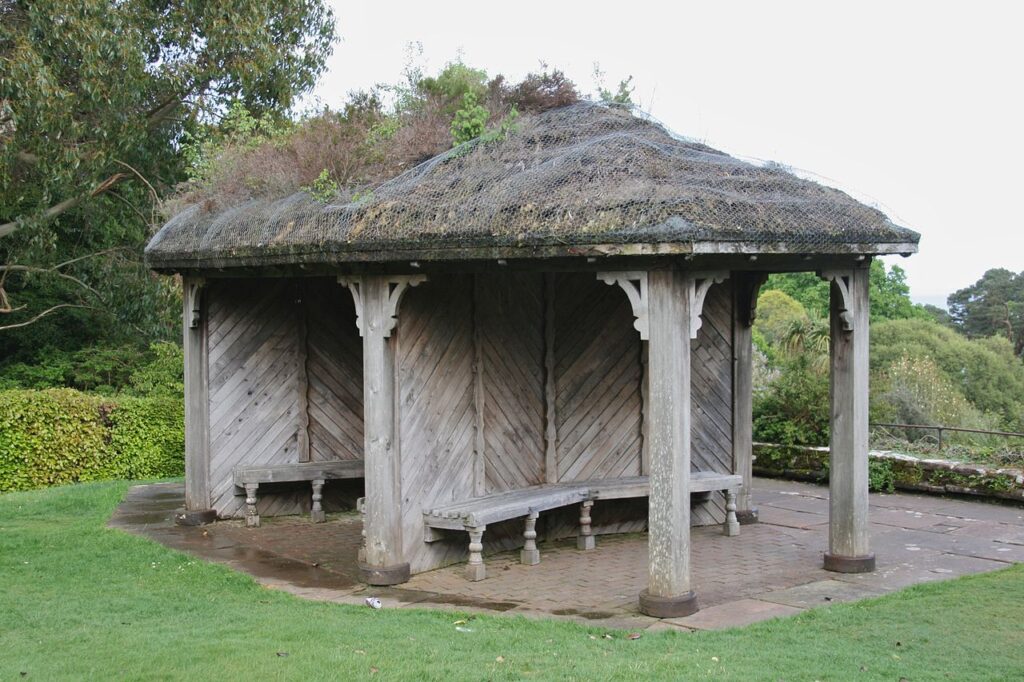
White heather is regarded in Scotland as being lucky, a tradition brought from Balmoral to England by Queen Victoria and sprigs of it are often sold as a charm and worked into bridal bouquets.
Different cultivars have flower colours ranging from white, through pink and a wide range of purples, and including reds. The flowering season with different cultivars extends from late July to November in the northern hemisphere. The flowers may turn brown but still remain on the plants over winter, and this can lead to interesting decorative effects. Cultivars with ornamental foliage are usually selected for reddish and golden leaf colour. A few forms can be silvery grey.
Several cultivars have gained the Royal Horticultural Society‘s Award of Garden Merit.
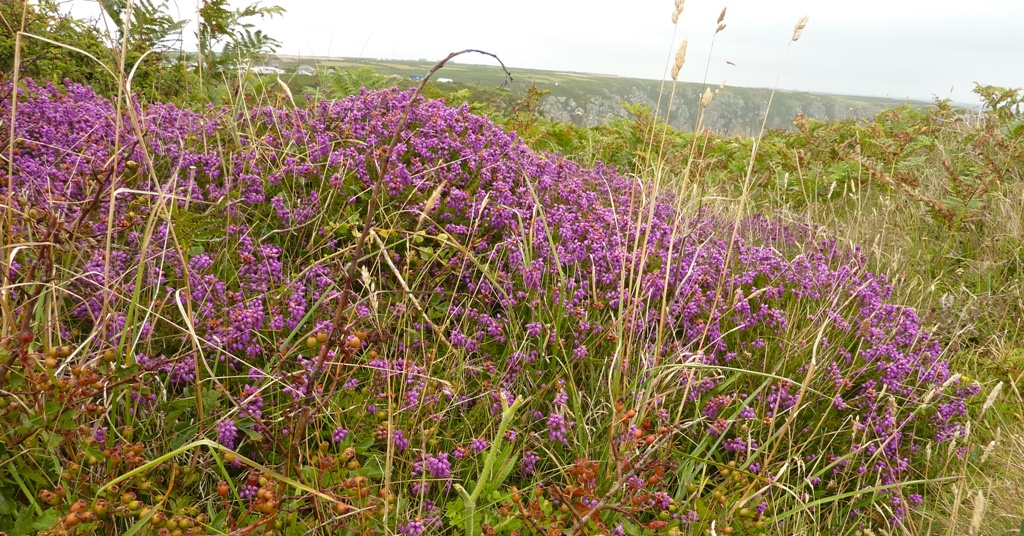
Erica spp. or Heaths
Ten species of Erica are described in Stace as well as several hybrids.
Plants of this genus are eaten mainly by the larvae of many Lepidoptera species, including emperor moth, garden tiger moth, true lover’s knot, wormwood pug, the silver-studded blue, and the Coleophora case-bearers C. juncicolella and C. pyrrhulipennella.
The following Erica species are natives:
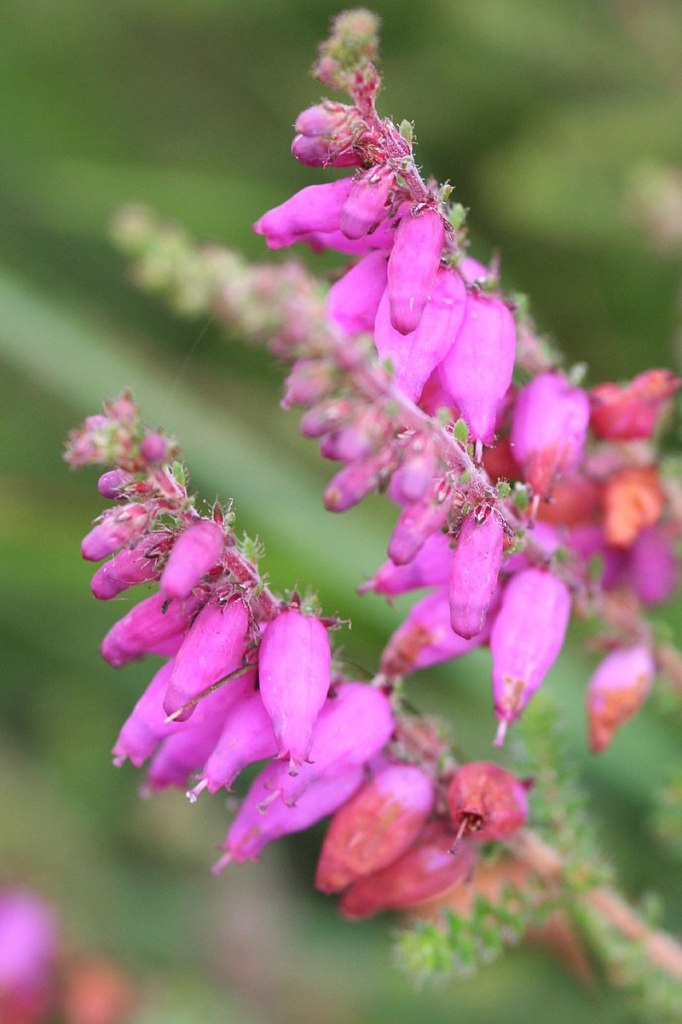
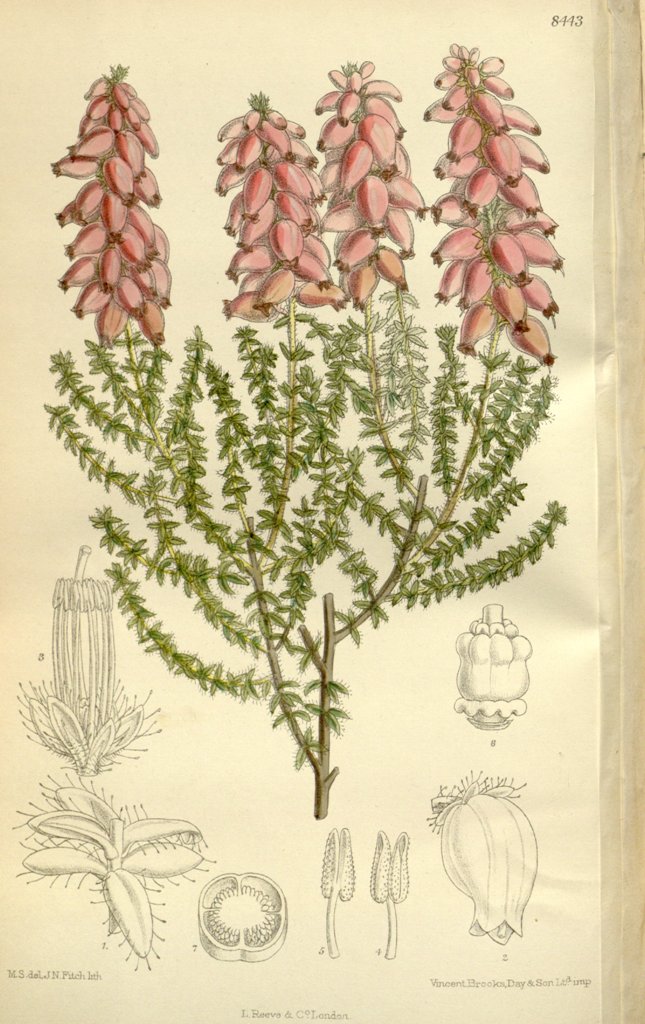
Erica ciliaris or Dorset Heath
This low shrub occurs on moist heathland, extending into relatively dry heath, and also into wet valley bogs, mainly on the drier hummocks. Seedlings establish on bare ground, but in closed habitats reproduction is usually vegetative.
E. mackayana or Mackay’s Heath
The habitats of this low shrub are blanket mire and rocky wet heath, where it occupies a somewhat narrower range of habitat than E. tetralix, avoiding the wettest sites. It grows on deep peat. The Irish plants of E. mackaiana never set seed. Their pollen fertility varies, but they produce sufficient fertile pollen to hybridise freely with E. tetralix to give the sterile hybrid E. x stuartii.
Flowering from mid-Summer to early Autumn, flower colour ranges from white (‘Shining Light’) through to amethyst (‘Errigal Dusk’) and magenta( ‘Galicia’). There is no known gold foliage plant in the species.
Erica mackayana f. eburnea ‘Shining Light’
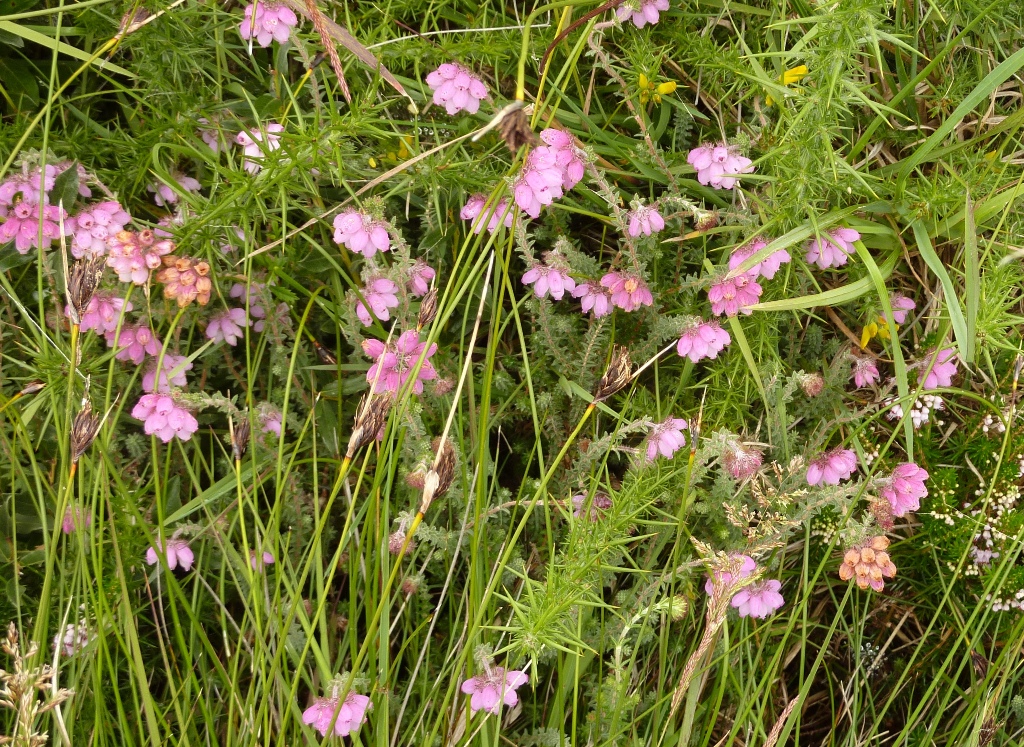
E. tetralix or Cross-leaved Heath
A sprawling low shrub found in a very wide range of mires and wet heaths, extending into drier heath in S.W. Britain. It is usually on wet, nutrient-poor organic soils, but can also grow in mesotrophic or eutrophic conditions.
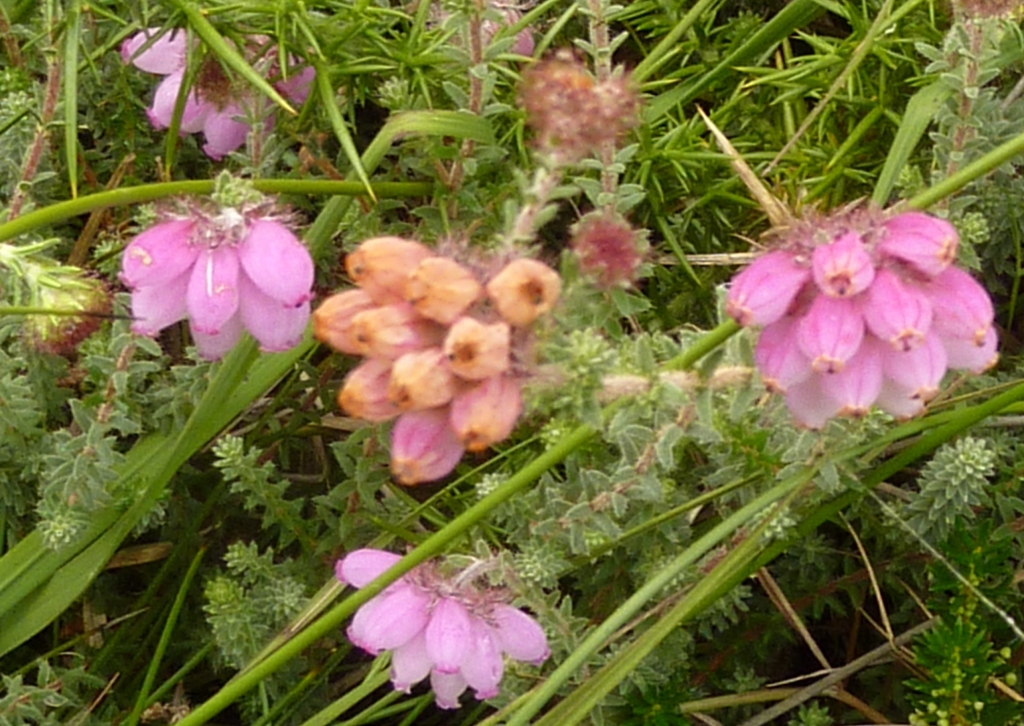
The difference with E. tetralix and the other native species, such as E. cinerea below, is that the linear leaves are usually glandular and in whorls of four, while those of E. cinerea are glabrous and borne in whorls of three.
In cultivation, like other heathers, E. tetralix requires an acidic soil, as it is a calcifuge. Numerous cultivars have been developed for garden use, of which E. tetralix form ‘Alba Mollis’ (a white-flowered variety) and E. tetralix ‘Pink Star’ have gained the Royal Horticultural Society‘s Award of Garden Merit.
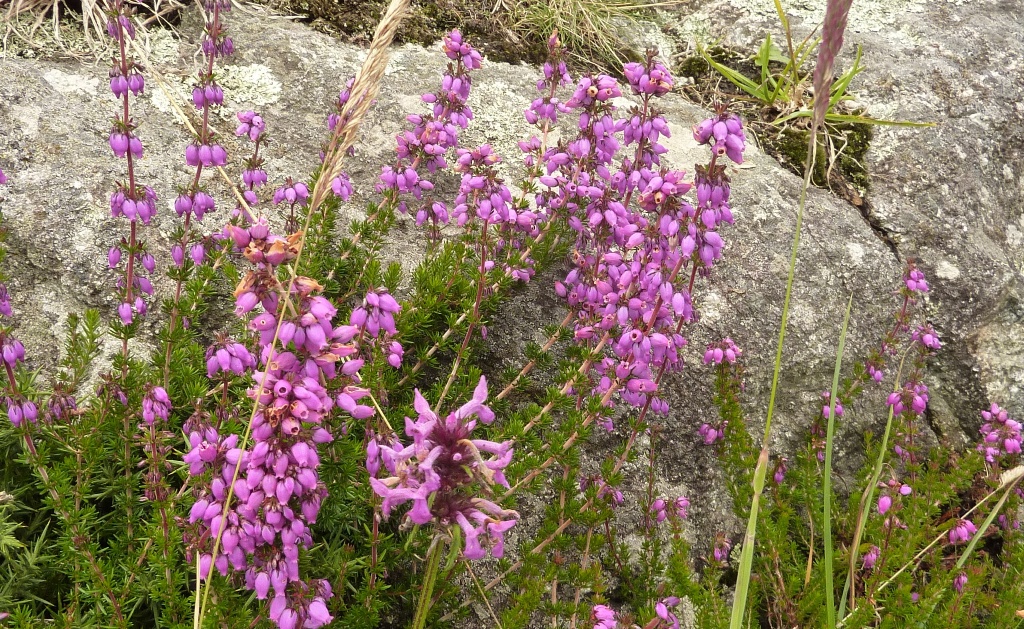
This small shrub occurs on thin, acidic, peaty or mineral soils in well-drained situations, on dry heaths, and as an occasional undershrub in open-canopy Pinus sylvestris or Quercus woodland. It is found in some calcareous grasslands that are leached and acidic at the surface (`limestone heath`).
The plant provides a great deal of nectar for pollinators. It was rated in the top 5 for most nectar production (nectar per unit cover per year) in a UK plants survey conducted by the AgriLand project which is supported by the UK Insect Pollinators Initiative.
Bell heather is a source of heather honey.
It is grown as an ornamental plant, cultivated in a wider range of colors. It is drought-tolerant and grows well in full sun with well-drained soil. Like most heathers, it is a calcifuge and dislikes alkaline soils (e.g. calcareous) which cause the symptoms of iron deficiency. Like other cultivated heathers, it is often seen as groundcover among plantings of dwarf conifers.
The cultivars below have gained the Royal Horticultural Society‘s Award of Garden Merit:
′Eden Valley′ has lavender flowers shading to white at the base of the corolla and a prostrate habit. The original plant was found on Trink Hill, Cornwall by Miss Gertrude Waterer.
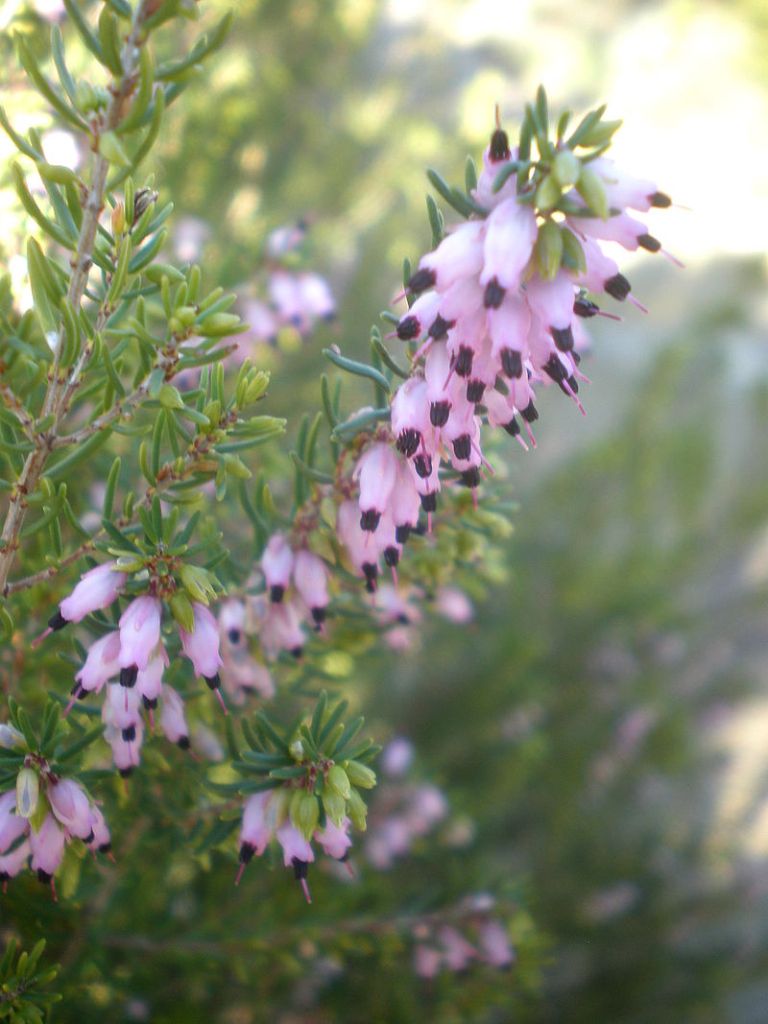
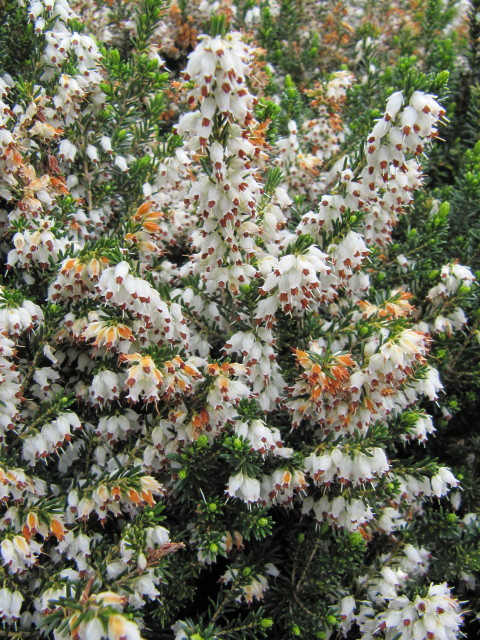
A shrub found in damp or boggy, more or less base-rich moorland, usually on slopes, often close to streams or on lake shores.
Although it is normally regarded as a native, Foss & Doyle (1988) have suggested that E. erigena might have been introduced to Ireland in the 15th century by pilgrims or traders.
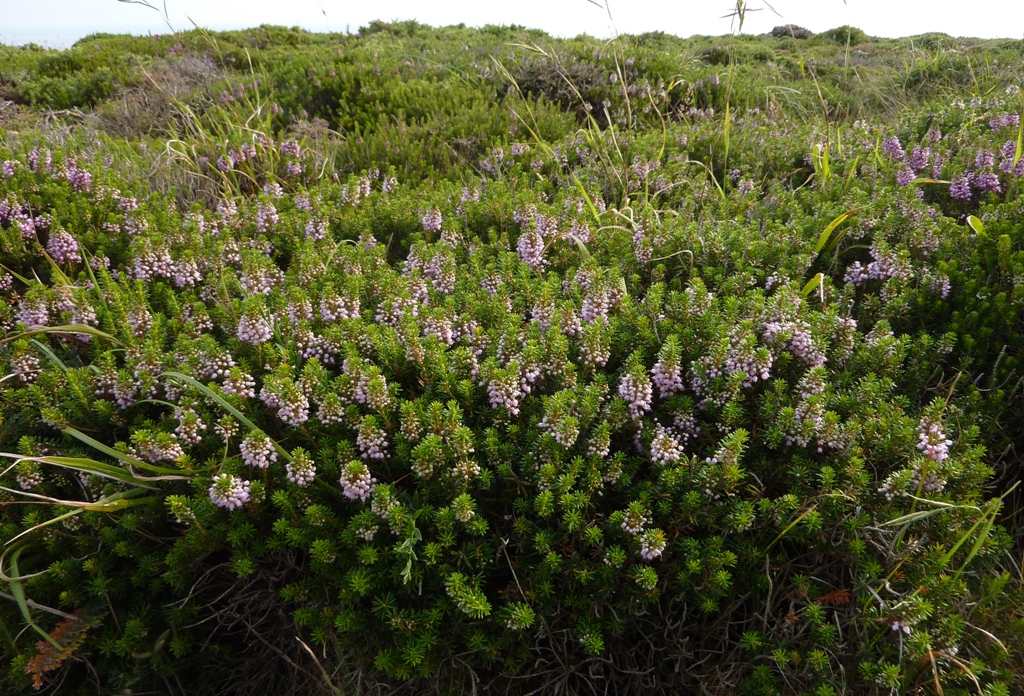
A locally abundant or co-dominant drawf srub in heathland with Calluna and Erica cinerea, or Ulex spp., often with calcicolous herbs, over ultrabasic rocks (serpentine and gabbro); also found on moist gley soils. Seedlings and plantlets can be frequent, but often die of drought; older plants regenerate from the base after winter burning.
The Latin specific epithet vagans literally means “wandering”; in this context it means “widely distributed”.
In Great Britain it is only found on the Lizard peninsula in southern Cornwall, where the unusual geology gives rise to the acid soils that it favours.
It is a vigorous, spreading, evergreen heather reaching 75 cm (30 in) tall and wide, with pink flowers borne in racemes 14 cm (6 in) long in summer and autumn.
Numerous cultivars have been developed with a range of flower colours in white, pink, mauve and purple. The following cultivars have gained the Royal Horticultural Society‘s Award of Garden Merit:
- E. vagans ‘Mrs D.F. Maxwell’
- E. vagans f. alba ‘Cornish Cream'(white-flowered variety)
- E. vagans f. alba ‘Kevernensis Alba’ (white-flowered variety)
- E. vagans f. alba ‘Lyonnesse’
- E. vagans f. aureifolia ‘Valerie Proudley'(gold-leaved variety)
It was voted the County flower of Cornwall in 2002 following a poll by the wild flora conservation charity Plantlife. It is often considered the Cornish floral emblem. According to one story this is because when Joseph of Arimathea first arrived in Cornwall looking for tin he had nowhere to stay, so he spent his first night on a bed of Cornish heather. In thankfulness, he blessed the plant and it has been a blessed plant ever since.
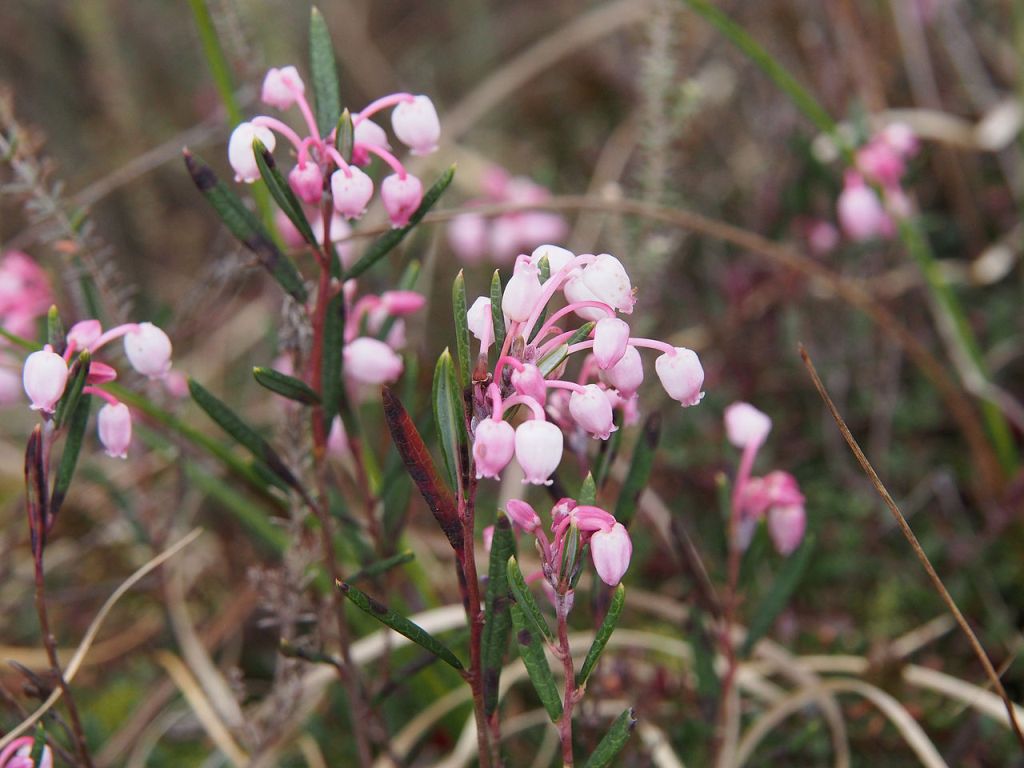
Andromeda polifolia or Bog-rosemary
A straggling dwarf shrub of moist to wet acidic peaty ground, most abundant in lowland raised bogs but with scattered occurrences on upland peats. Fruits seldom develop.
The common name “bog rosemary” derives from the superficial resemblance of the leaves to those of rosemary, which is not closely related.
Numerous cultivars have been developed for garden use, all of which require damp acid soil in shade. The cultivars ‘Compacta’and ‘Macrophylla’ have gained the Royal Horticultural Society’s Award of Garden Merit. Like most other members of the family Ericaceae, they are acid-loving plants (calcifuges), and must be grown in a medium with a low pH.
Leucothoe fontanesiana or Dog-hubble
This is an introduced Garden shrub and occasionally found in woodlands where originally planted.
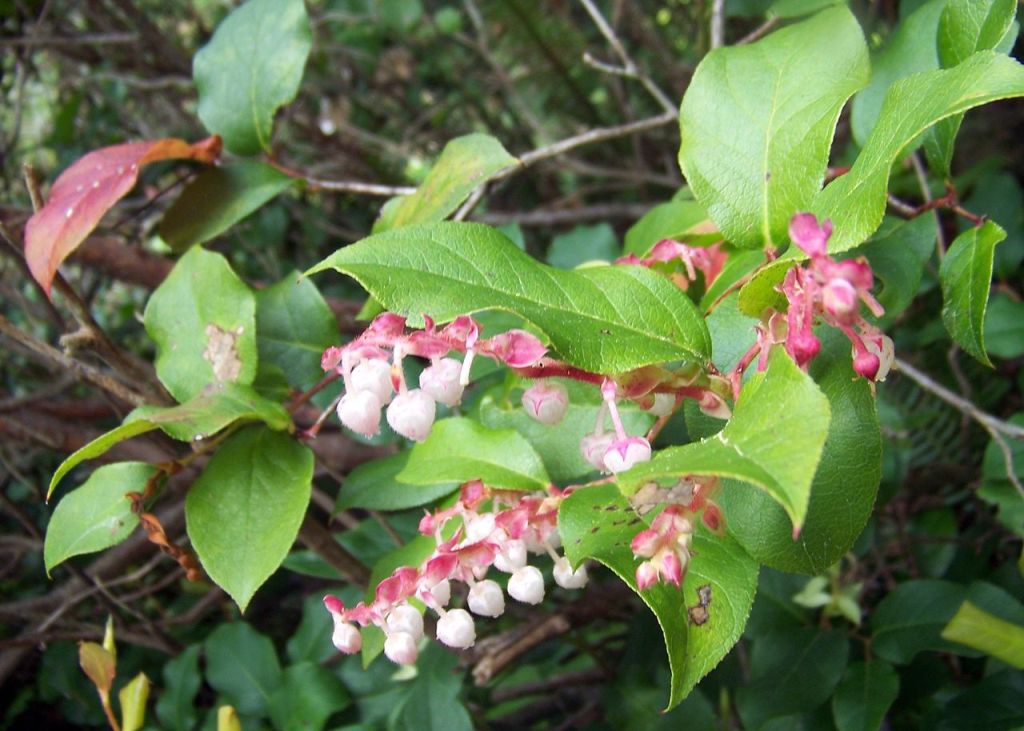
Gaultheria spp or Shallons
According to Wikipedia this genus has 135 species but only 3 species are described in Stace and they are all introduced small shrubs used as groundcover.
Ornamental Uses:
All species are good garden plants and some, like Shallon is used in Floristry as long lasting foliage. This species is however also becoming a problem in Forrests.
Confusingly some of the species of Gaultheria also have the common name of ‘Wintergreens’ as several of the other genera below namely Pyrola, Orthilia and Moneses. These last 3 species growing in the B.I. have however nothing to do with the wintergreen essential oil. Read more in the link below.
Wintergreen essential oil is traditionally derived from the wintergreen plant. There are two species that can be used to produce the oil: Gaultheria procumbens (native to North America) and Gaultheria fragrantissima (native to Asia and India).
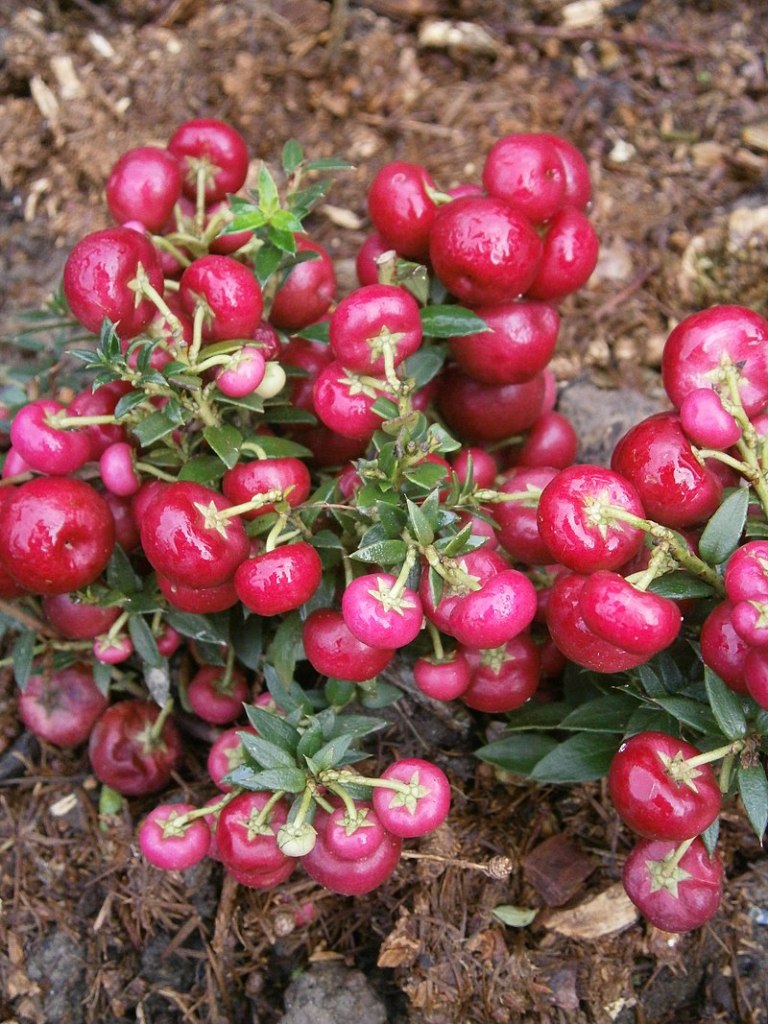
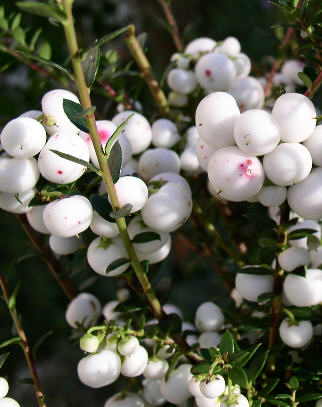
G. mucronata or Prickly Heath (syn. Pernettya mucronata)
Numerous cultivars have been selected for garden use, of which the following have gained the Royal Horticultural Society‘s Award of Garden Merit:
- ‘Bell’s Seedling’ (deep red fruit)
- ‘Crimsonia’ (large crimson fruits)
- ‘Mulberry Wine (purple fruit)
- ‘Wintertime’ (white fruits)
Vaccinium spp. or Bilberries
Seven species are described in Stace:
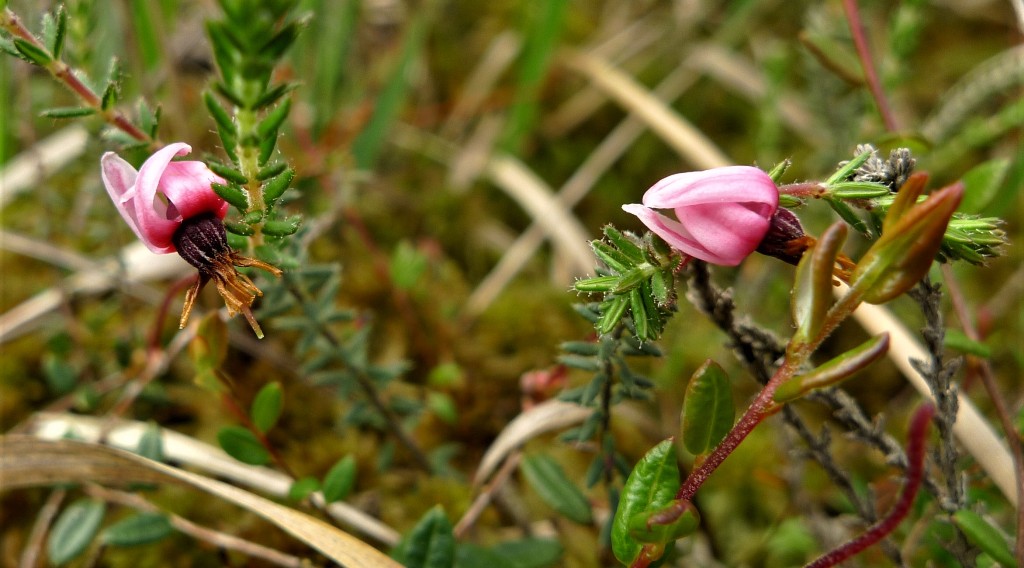
Vaccinium oxycoccus or Cranberry
A slender, trailing dwarf shrub found in bogs and on very wet heaths, usually creeping amongst Sphagnum.
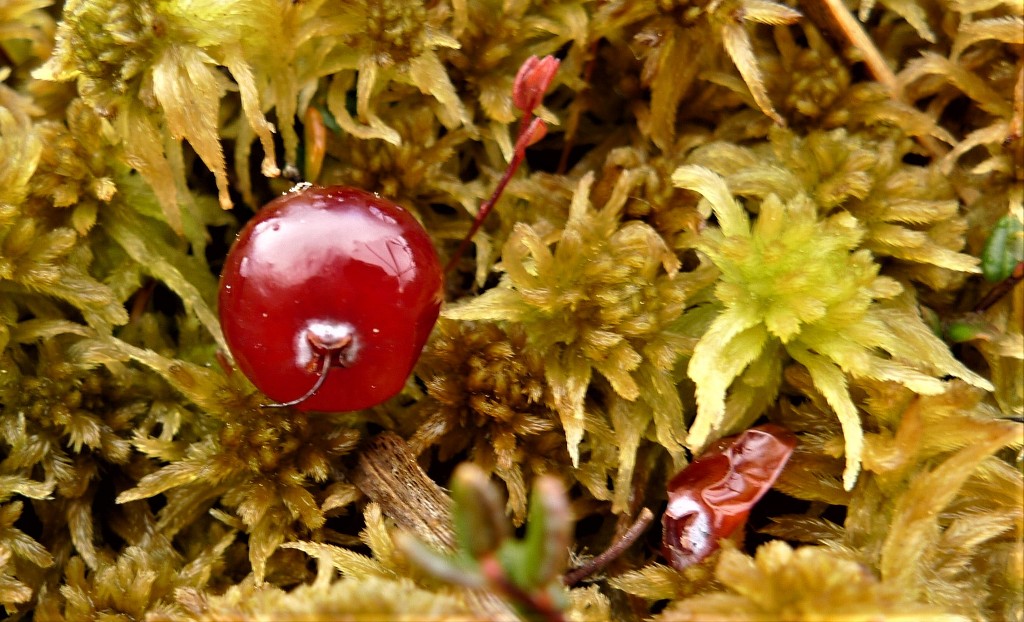
- Fruit – raw or cooked. Considered by some to be the most pleasantly-flavoured of British wild fruits. The fruit is high in pectin, this means that it can be mixed with fruits that are low in pectin to help them set when making jam[K].
- A tea is made from the leaves.
An infusion of the plant has been used to treat cases of slight nausea. Treatment for urinary infections – cystitis, and scurvy
Vaccinium microcarpum or Small Cranberry
This trailing dwarf shrub occurs exclusively in Sphagnum mires, generally forming colonies in the drier microhabitats including the tops of hummocks.
V. macrocarpon or American Cranberry
A non native (neophyte), evergreen shrub found as a naturalised garden escape on acidic, boggy ground.
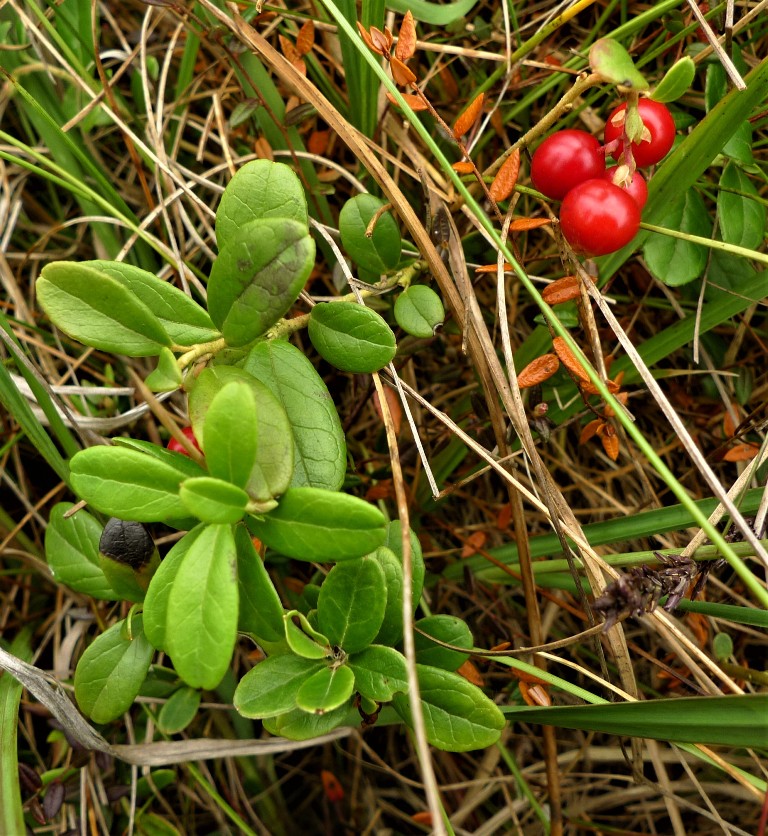
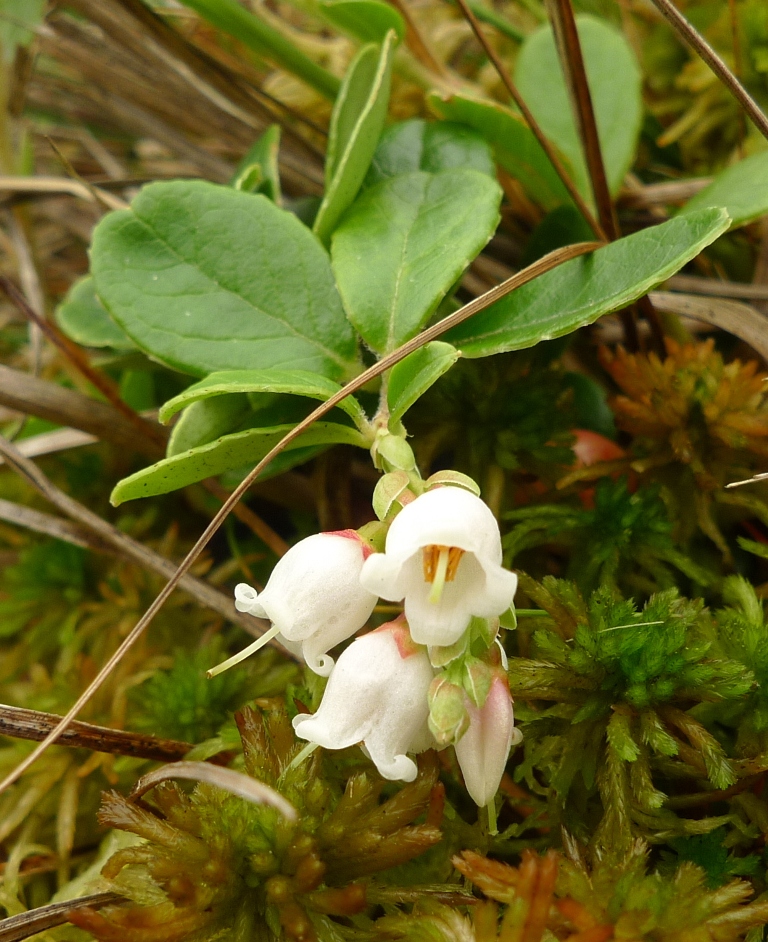
V. vitis- idaea or Lingonberry and Cowberry
There are at least 25 other common English names of Vaccinium vitis-idaea worldwide. The name ‘lingonberry’ originates from the Swedish name lingon for the species, and is derived from the Norse lyngr, or heather.
This calcifuge, evergreen shrub is found on peaty heaths and moorland, in the understorey of Quercus, Betula and Pinus woods on acidic substrates, and on drier hummocks in blanket bogs.
The berries collected in the wild are a popular fruit in northern, central and eastern Europe, notably in Nordic countries, the Baltic states, central and northern Europe. In some areas, they can be picked legally on both public and private lands in accordance with the freedom to roam.
There are also some traditional medicinal as well as other uses mentioned in Wikipedia link. They are not so much used in the B.I. except for
Some cultivars are grown for their ornamental rather than culinary value. In the United Kingdom, the Koralle Group has gained the Royal Horticultural Society‘s Award of Garden Merit.
V. x intermedium (V. vitis-idaea x V. myrtillus) or Hybrid Bilberry
This evergreen occurs very locally with the parents in Staffs, Derbyshire and Yorkshire according to Stace. It is intermediate in all its characters between the parents. It was first gathered by a Prof. Bonney in 1886 on Cannock Chase. See this article here.
Only one old record in Sutton Park by Bagnall in 1889 according to the Flora of Birmingham and the Black Country.
Has at least one use as an ornamental shrub.
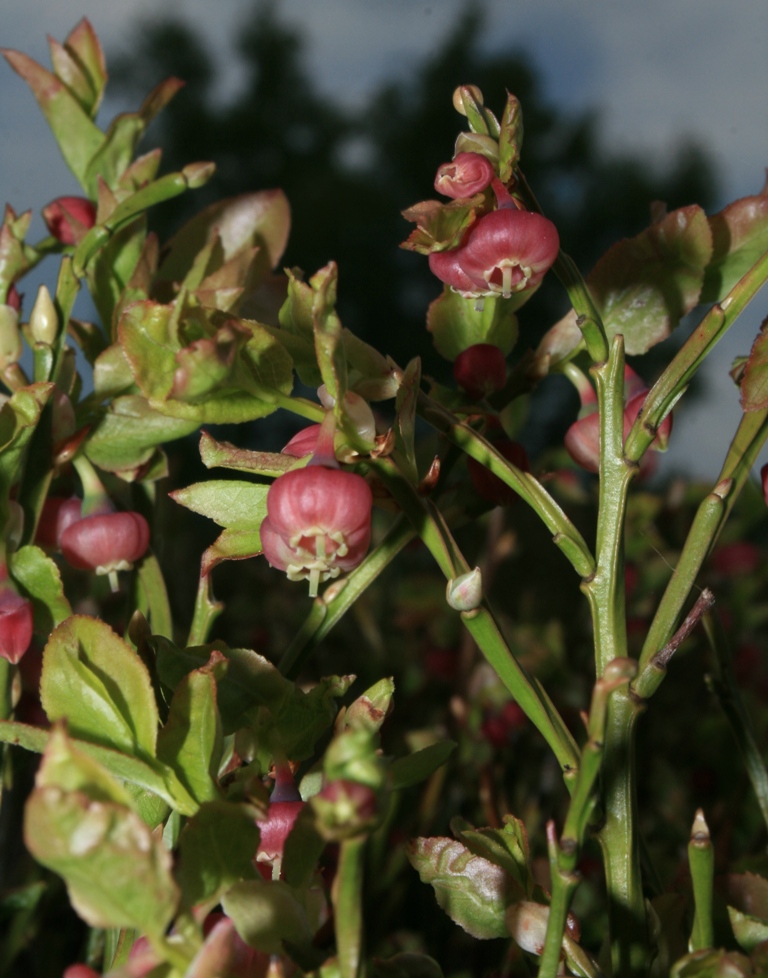
A calcifugous, deciduous, low shrub, common and locally dominant in well-drained heaths and moorland, especially in upland areas, and as an understorey in acid woodland of Betula, Pinus and Quercus; also found on hummocks in peat bogs in the north and west. It rarely regenerates from seed.
- Fruit can be eaten raw or cooked.
- They make an excellent preserve, their small seeds making them suitable for jam.
- A slightly acid flavour when eaten raw.
- The fruit can be dried and used like currants.
- A tea is made from the leaves.
- The leaves contain glucoquinones, which reduce the levels of sugar in the blood.
- A decoction of the leaves or bark is applied locally in the treatment of ulcers and in ulceration of the mouth and throat.
- A distilled water made from the leaves is an excellent eyewash for soothing inflamed or sore eyes.
- Whilst the fresh fruit has a slightly laxative effect upon the body, when dried it is astringent and is commonly used in the treatment of diarrhoea etc.
- The dried fruit is also antibacterial and a decoction is useful for treating diarrhoea in children.
- The skin of the fruits contains anthocyanin and is specific in the treatment of hemeralopia (day-blindness).
- The fruit is a rich source of anthocyanosides, which have been shown experimentally to dilate the blood vessel, this makes it a potentially valuable treatment for varicose veins, haemorrhoids and capillary fragility.
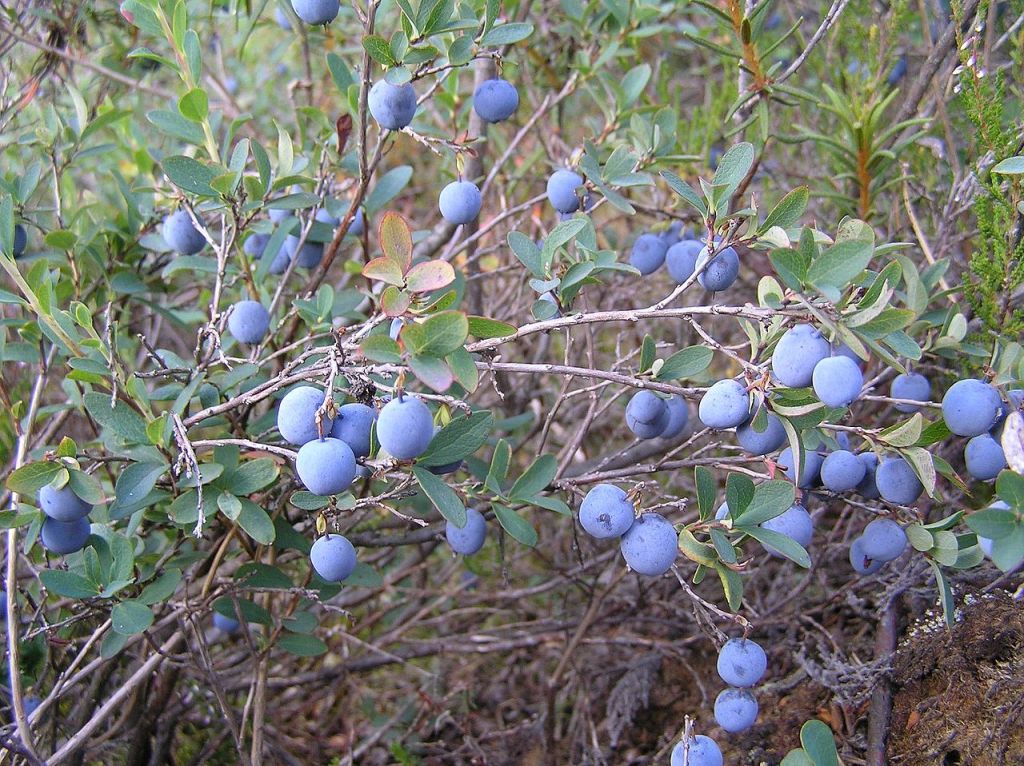
A low shrub, locally common on podsolic or peaty acidic soils in upland dwarf-shrub heaths and blanket bog, occasionally in Nardus-Carex bigelowii heath; also, rarely, in calcareous Dryas communities on montane ledges.
- Fruit can be eaten raw or cooked and can also be dried and used like raisins.
- A tea is made from the leaves and dried fruits.
- It has a reasonable source of vitamin C.
Caution :
The fruit can cause headaches if they are eaten in large quantities! This is probably the result of infestation by a fungus.
The plant or berries are antidiarroehal, antiseptic, astringent, carminative, hypnotic and hypoglycaemic. An infusion of the leaves and sugar have been given to a mother a few days after childbirth in order to help her regain her strength.
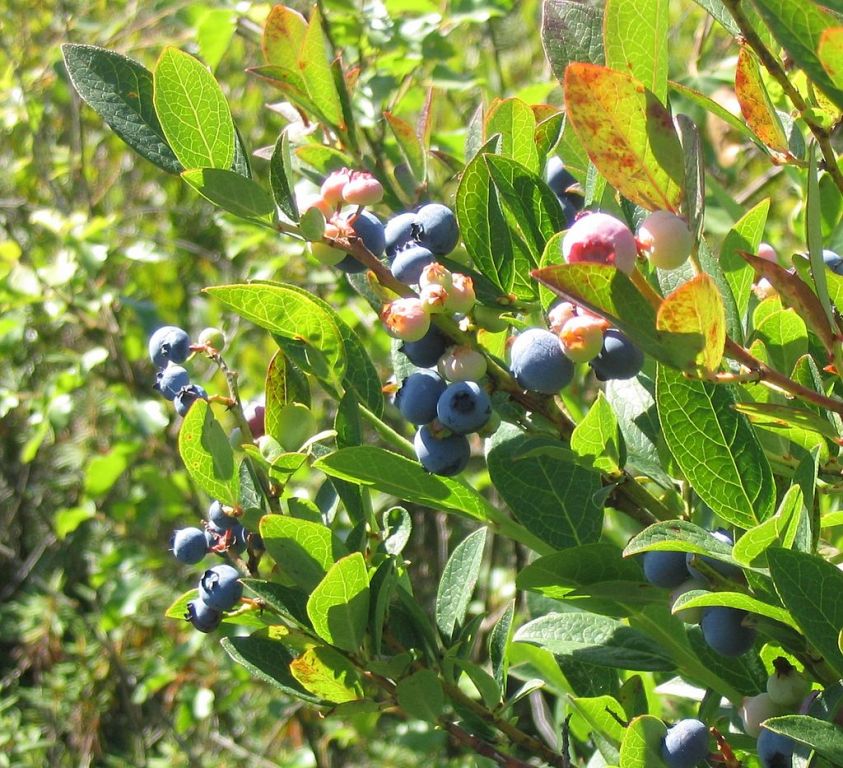
V. corymbosum or Highbush Blueberry
A deciduous shrub found as a naturalised garden escape on heaths and in Pinus plantations. Reproduction is by seed.
This is a North American species of blueberry which has become a food crop of significant economic importance. It is native to eastern Canada and the eastern and southern United States, from Ontario east to Nova Scotia and south as far as Florida and eastern Texas. It is also naturalized in other places including Europe.
The cultivars Duke and Spartan have gained the Royal Horticultural Society‘s Award of Garden Merit.
Blueberries are sold fresh or are processed as individually quick frozen (IQF) fruit, purée, juice, or dried or infused berries. These may then be used in a variety of consumer goods, such as jellies, jams, pies, muffins, snack foods, pancakes, or as an additive to breakfast cereals.
They contain only negligible amounts of micronutrients, with moderate levels (relative to respective Daily Values) (DV) of the essential dietary mineral manganese, vitamin C, vitamin K and dietary fiber (table).
It is also cultivated as an ornamental plant for home and wildlife gardens and natural landscaping projects. The pH must be very acidic (4.5 to 5.5).
Pyrola spp. or Wintergreens
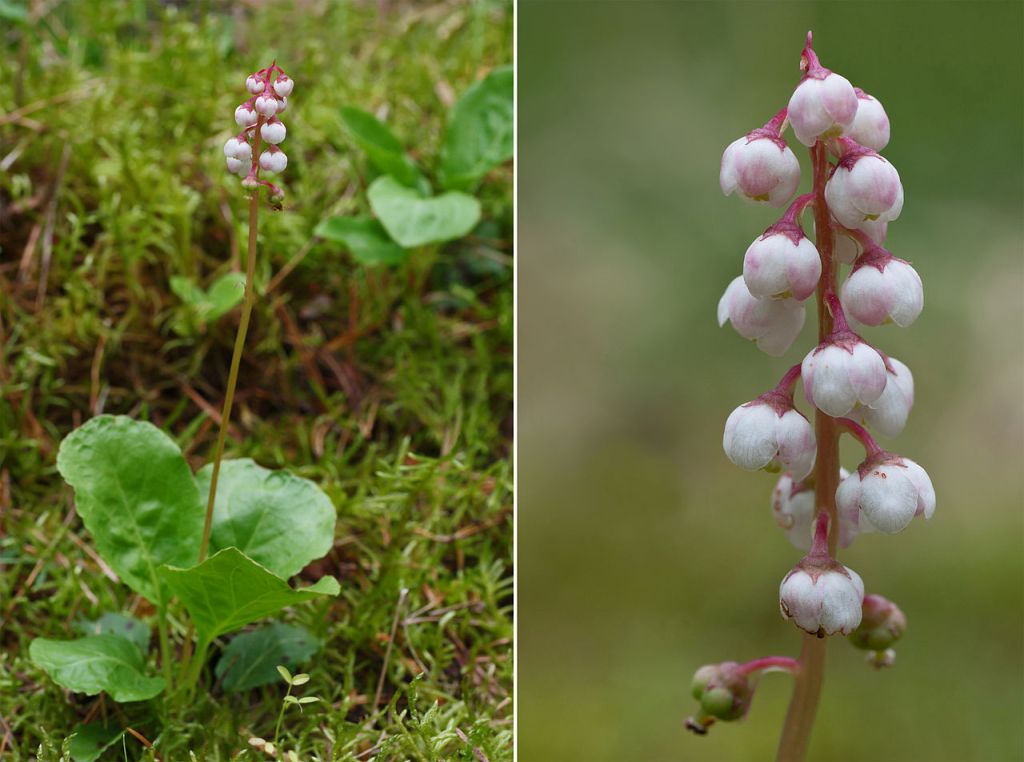
Pyrola minor or Common Wintergreen
A rhizomatous, mycorrhizal, perennial evergreen herb. In S. England it is a plant of damp woodlands with deep litter, on a variety of soils; elsewhere it occurs in damp places in heaths, plantations, disused railways, on rock ledges and in sand dunes.
The fruit and raw leaves are edible according to PFAF but not much info can be found!
The plant is antispasmodic, astringent, diuretic and tonic.
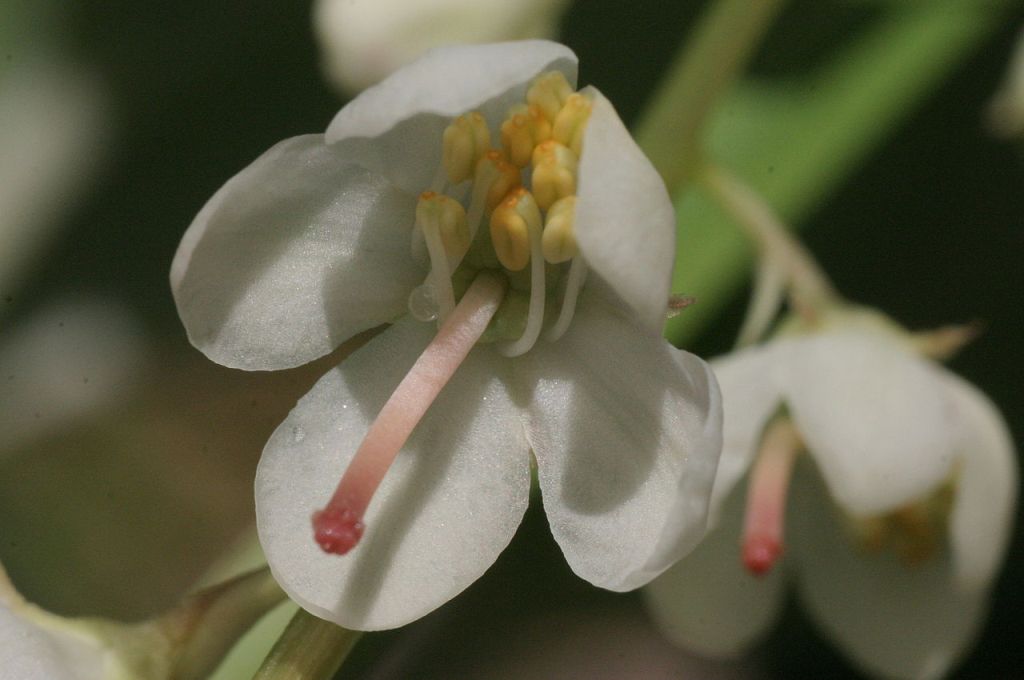
Pyrola media or Intermediate Wintergreen
A rhizomatous, mycorrhizal, evergreen perennial herb of well-drained, mildly acidic to slightly basic soils in woods and on heaths. It is characteristic of Arctostaphylos-Calluna submontane heath derived from former woodland.
According to Wikipedia: This is native to northern and eastern Europe and Western Asia and rare and declining in the British Isles.
Pyrola rotundifolia or Round-leaved Wintergreen
This has 2 Subspecies known on the B.I.:
Pyrola rotundifolia ssp. rotundifolia
A rhizomatous, mycorrhizal, evergreen perennial herb. In England it usually grows in damp, calcareous sites including fens, disused chalk-pits and dune-slacks. In Scotland it inhabits open Pinus sylvestris woodland, river banks and gullies in open moorland, and montane cliff ledges.
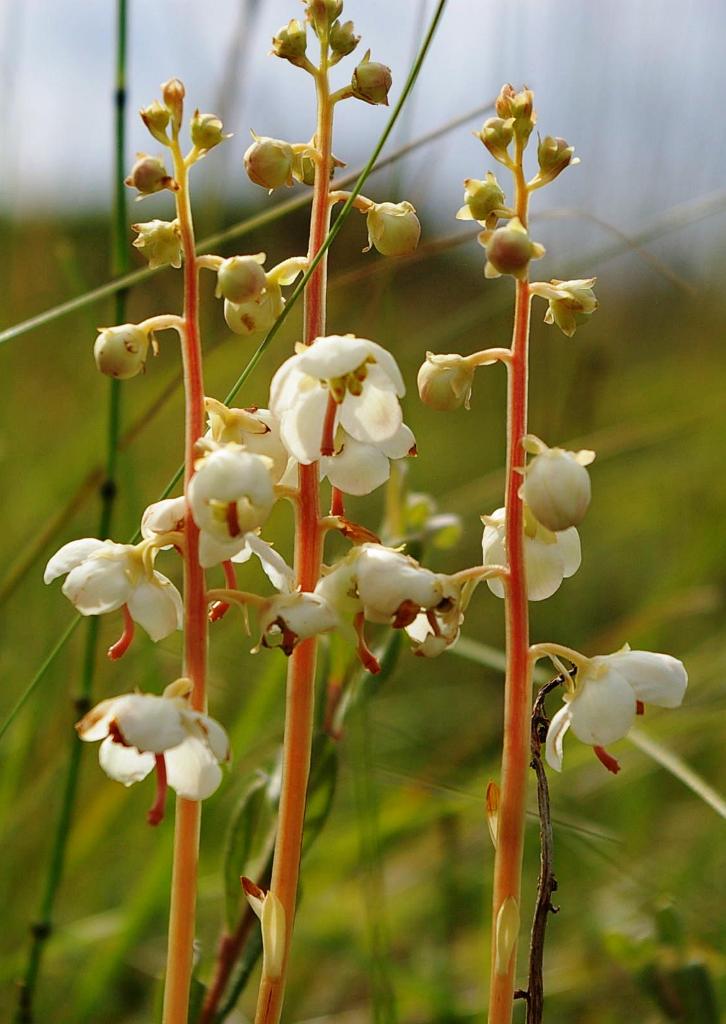
And Pyrola rotundifolia ssp. maritima
A rhizomatous, mycorrhizal, evergreen perennial herb of calcareous dune-slacks and nearby fixed dunes. It usually grows with Salix repens on the drier fringes of wet slacks, but also persists in conifer plantations on fixed dunes.
The leaves are antirheumatic, antiseptic, antispasmodic, astringent, cardiotonic, contraceptive, diuretic, poultice, sedative and tonic.
- A decoction is used in the treatment of skin diseases, as a gargle and a wash for the eyes.
- It is used internally in the treatment of epilepsy and other nervous afflictions.
- The plant contains arbutin, a proven diuretic and antibacterial agent that is used as a urinary antiseptic, this hydrolyzes in the body into the toxic hydroquinone
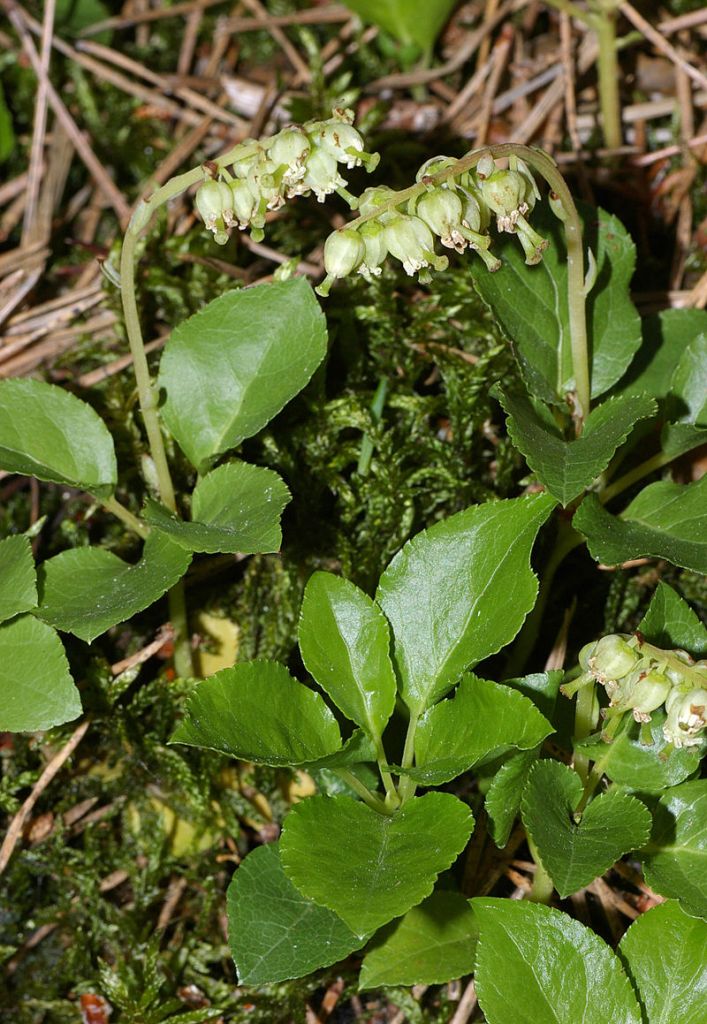
Orthilia secunda or Serrated Wintergreen
A rhizomatous, mycorrhizal, evergreen perennial herb, of damp Calluna and Vaccinium-dominated communities, mostly in Pinus and Betula woodland but also on open moorland. It also grows in clefts and on ledges in rocky gullies, and on rocky stream banks. Flowering is often erratic.
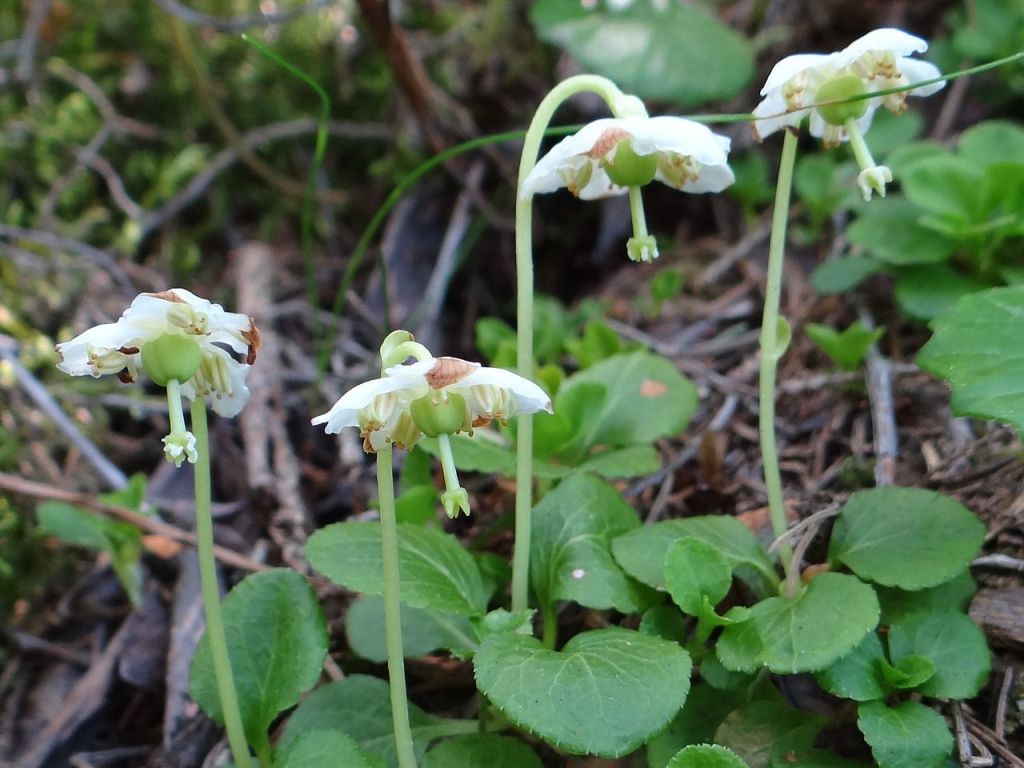
Moneses uniflora or One-flowered Wintergreen
A mycorrhizal, evergreen perennial herb, spreading by rhizomes within leaf litter and bryophytes in ericaceous dwarf shrub communities of old pine plantations, rarely now in native Pinus sylvestris forests. The solitary flower is insect-pollinated, but recruitment from seed is rare and most propagation is vegetative.
Moneses uniflora has long and significant histories with several Indigenous nations across North America. Read more in Wikipedia.
- An infusion of the dried plant has been used in the treatment of coughs and colds.
- The plant has been chewed, and the juice swallowed, as a treatment for sore throat.
- A poultice of the leaves has been used to draw out the pus from boils and abscesses, to draw blisters, to help reduce swellings and also to relieve pain.
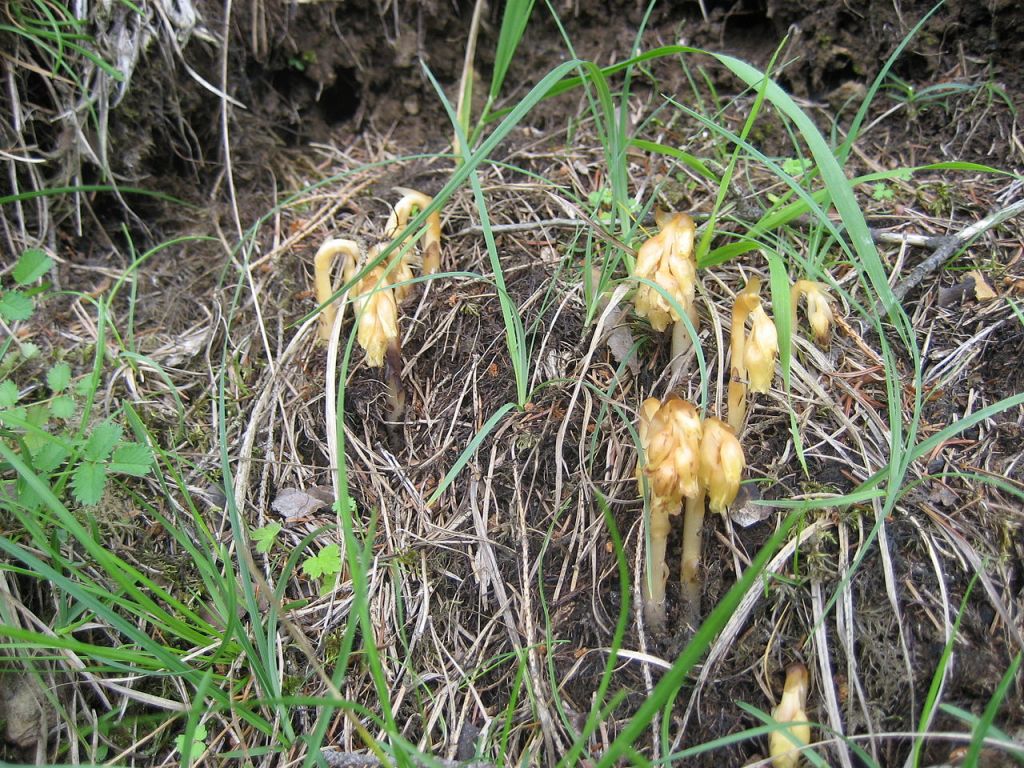
Monotropa hypopitys or Hypopitys monotropa or Yellow Bird’s-nest
We are finishing the Ericaceae family with an interesting saprophytic member!
The Online Atlas of the B.I. names this genus Monotropa. According to Wikipedia:
While currently included in the genus Monotropa, recent genetic evidence strongly suggests that Monotropa hypopitys should be placed in its own genus, Hypopitys, with the single species Hypopitys monotropa Crantz, but possibly containing several other species.
Two subspecies of Hypopitys monotropa are listed in Stace:
H. monotropa ssp. monotropa
and H. monotropa ssp. hypophegea
A saprophytic perennial herb of leaf litter in shaded woodlands, most frequent under Fagus and Corylus on calcareous substrates, and under Pinus on more acidic soils. It also grows in damp dune-slacks, where it is usually associated with Salix repens.
